
List of locomotives in the UK National Collection
Encyclopedia

Rolling stock
Rolling stock comprises all the vehicles that move on a railway. It usually includes both powered and unpowered vehicles, for example locomotives, railroad cars, coaches and wagons...
(predominantly of British origin). The majority of the collection is kept at three national museums:
- National Railway MuseumNational Railway MuseumThe National Railway Museum is a museum in York forming part of the British National Museum of Science and Industry and telling the story of rail transport in Britain and its impact on society. It has won many awards, including the European Museum of the Year Award in 2001...
, York - LocomotionShildon Locomotion MuseumShildon Locomotion Museum is a railway museum in Shildon, County Durham, England. The museum is a branch of the National Railway Museum , which is part of the National Museum of Science and Industry...
, Shildon - Science MuseumScience Museum (London)The Science Museum is one of the three major museums on Exhibition Road, South Kensington, London in the Royal Borough of Kensington and Chelsea. It is part of the National Museum of Science and Industry. The museum is a major London tourist attraction....
, Kensington, London
Other items are on short or long-term loans to museums and heritage railway
Heritage railway
thumb|right|the Historical [[Khyber train safari|Khyber Railway]] goes through the [[Khyber Pass]], [[Pakistan]]A heritage railway , preserved railway , tourist railway , or tourist railroad is a railway that is run as a tourist attraction, in some cases by volunteers, and...
s such as the Museum of the Great Western Railway at Swindon and the Railway Centre and Museum
Darlington Railway Centre and Museum
Darlington Railway Centre and Museum, also known as Head of Steam, is located on the 1825 route of the Stockton and Darlington Railway which was the world's first steam powered passenger railway. Run by Darlington Borough Council the museum is located in the northern suburbs of Darlington in the...
at Darlington.
Standard gauge designs up to 1869
These locomotives are all gauge unless noted otherwise.| Railway | Number and name | Type or Class | Builder | Works Number |
Built | Wheels | Location | Object Number | Image |
|---|---|---|---|---|---|---|---|---|---|
| Wylam Colliery | Puffing Billy Puffing Billy (locomotive) Puffing Billy is an early railway steam locomotive, constructed in 1813-1814 by engineer William Hedley, enginewright Jonathan Forster and blacksmith Timothy Hackworth for Christopher Blackett, the owner of Wylam Colliery near Newcastle upon Tyne, in the United Kingdom. It is the world's oldest... |
William Hedley William Hedley William Hedley was one of the leading industrial engineers of the early 19th century, and was very instrumental in several major innovations in early railway development... |
1813 Rebuilt c.1830 |
4w VCGPuffing Billy is gauge. | Kensington Science Museum (London) The Science Museum is one of the three major museums on Exhibition Road, South Kensington, London in the Royal Borough of Kensington and Chelsea. It is part of the National Museum of Science and Industry. The museum is a major London tourist attraction.... |
1862-2 |  |
||
| Hetton Colliery Hetton colliery railway The Hetton colliery railway was an 8-mile-long private railway opened in 1822 by the Hetton Coal Company at Hetton Lyons, County Durham, England. It was the first to be designed from the start to be operated without animal power, and was George Stephenson's first entirely new line. When it closed... |
George Stephenson George Stephenson George Stephenson was an English civil engineer and mechanical engineer who built the first public railway line in the world to use steam locomotives... |
1822 | 0-4-0 0-4-0 Under the Whyte notation for the classification of steam locomotives, 0-4-0 represents one of the simplest possible types, that with two axles and four coupled wheels, all of which are driven... |
Beamish Beamish Museum Beamish, The North of England Open Air Museum is an open-air museum located at Beamish, near the town of Stanley, County Durham, England. The museum's guiding principle is to preserve an example of everyday life in urban and rural North East England at the climax of industrialisation in the early... |
1978-7009 | ||||
| S&D Stockton and Darlington Railway The Stockton and Darlington Railway , which opened in 1825, was the world's first publicly subscribed passenger railway. It was 26 miles long, and was built in north-eastern England between Witton Park and Stockton-on-Tees via Darlington, and connected to several collieries near Shildon... |
Locomotion No 1 Locomotion No 1 Locomotion No. 1 is an early British steam locomotive. Built by George and Robert Stephenson's company Robert Stephenson and Company in 1825, it hauled the first train on the Stockton and Darlington Railway on 27 September 1825.... |
R Stephenson Robert Stephenson and Company Robert Stephenson and Company was a locomotive manufacturing company founded in 1823. It was the first company set up specifically to build railway engines.- Foundation and early success :... |
3 | 1825 | 0-4-0 0-4-0 Under the Whyte notation for the classification of steam locomotives, 0-4-0 represents one of the simplest possible types, that with two axles and four coupled wheels, all of which are driven... |
Darlington Darlington Railway Centre and Museum Darlington Railway Centre and Museum, also known as Head of Steam, is located on the 1825 route of the Stockton and Darlington Railway which was the world's first steam powered passenger railway. Run by Darlington Borough Council the museum is located in the northern suburbs of Darlington in the... |
1978-7010 | ||
| Shutt End Colliery | Agenoria | Foster, Rastrick and Company Foster, Rastrick and Company Foster, Rastrick and Company was one of the pioneering steam locomotive manufacturing companies of England. It was based in Stourbridge, Worcestershire, now West Midlands.... |
1829 | 0-4-0 0-4-0 Under the Whyte notation for the classification of steam locomotives, 0-4-0 represents one of the simplest possible types, that with two axles and four coupled wheels, all of which are driven... |
York National Railway Museum The National Railway Museum is a museum in York forming part of the British National Museum of Science and Industry and telling the story of rail transport in Britain and its impact on society. It has won many awards, including the European Museum of the Year Award in 2001... |
1884-92 | |||
| L&M Liverpool and Manchester Railway The Liverpool and Manchester Railway was the world's first inter-city passenger railway in which all the trains were timetabled and were hauled for most of the distance solely by steam locomotives. The line opened on 15 September 1830 and ran between the cities of Liverpool and Manchester in North... |
Rocket Stephenson's Rocket Stephenson's Rocket was an early steam locomotive of 0-2-2 wheel arrangement, built in Newcastle Upon Tyne at the Forth Street Works of Robert Stephenson and Company in 1829.- Design innovations :... |
R Stephenson | 19 | 1829 | 0-2-2 0-2-2 An 0-2-2, in the Whyte notation for the classification of steam locomotives by wheel arrangement, is one that has two coupled driving wheels followed by two trailing wheels, with no leading wheels... |
Kensington | 1862-5 | 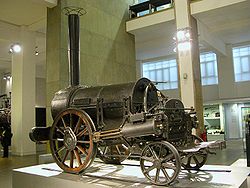 |
|
| S&D | Rocket | Replica | 1935Sectionalised replica of original Rocket of 1829. | 0-2-2 0-2-2 An 0-2-2, in the Whyte notation for the classification of steam locomotives by wheel arrangement, is one that has two coupled driving wheels followed by two trailing wheels, with no leading wheels... |
Shildon | 1935-87 |  |
||
| S&D | Rocket | Replica | Locomotion Enterprises (1975) Ltd. | 2 | 1979Working replica of original Rocket of 1829. | 0-2-2 0-2-2 An 0-2-2, in the Whyte notation for the classification of steam locomotives by wheel arrangement, is one that has two coupled driving wheels followed by two trailing wheels, with no leading wheels... |
York | 1979-7002 |  |
| L&M | Sans Pareil Sans Pareil Sans Pareil is a steam locomotive built by Timothy Hackworth which took part in the 1829 Rainhill Trials on the Liverpool and Manchester Railway, held to select a builder of locomotives... |
Timothy Hackworth Timothy Hackworth Timothy Hackworth was a steam locomotive engineer who lived in Shildon, County Durham, England and was the first locomotive superintendent of the Stockton and Darlington Railway.- Youth and early work :... |
1829 | 0-4-0 0-4-0 Under the Whyte notation for the classification of steam locomotives, 0-4-0 represents one of the simplest possible types, that with two axles and four coupled wheels, all of which are driven... |
Shildon Shildon Locomotion Museum Shildon Locomotion Museum is a railway museum in Shildon, County Durham, England. The museum is a branch of the National Railway Museum , which is part of the National Museum of Science and Industry... |
1864-45 |  |
||
| L&M | Sans Pareil | Replica | 1979Working replica of original Sans Pareil. | 0-4-0 0-4-0 Under the Whyte notation for the classification of steam locomotives, 0-4-0 represents one of the simplest possible types, that with two axles and four coupled wheels, all of which are driven... |
Shildon | 2009-7054 | |||
| L&M | Novelty Novelty (locomotive) Novelty was an early steam locomotive built by John Ericsson and John Braithwaite to take part in the Rainhill Trials in 1829.It was an 0-2-2WT locomotive and is now regarded as the very first tank engine. It had a unique design of boiler and a number of other novel design features... |
Ericsson John Ericsson John Ericsson was a Swedish-American inventor and mechanical engineer, as was his brother Nils Ericson. He was born at Långbanshyttan in Värmland, Sweden, but primarily came to be active in England and the United States... and Braithwaite |
1829Novelty was rebuilt in 1929 | 0-2-2 0-2-2 An 0-2-2, in the Whyte notation for the classification of steam locomotives by wheel arrangement, is one that has two coupled driving wheels followed by two trailing wheels, with no leading wheels... |
Manchester Museum of Science and Industry in Manchester The Museum of Science and Industry in Manchester, England, is a large museum devoted to the development of science, technology, and industry with emphasis on the city's achievements in these fields... |
1929-866 | 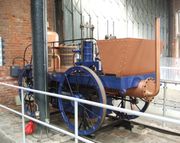 |
||
| Hetton Colliery | Bradyll Bradyll (locomotive) Bradyll is an early steam locomotive built by Timothy Hackworth at his Soho Works in Shildon, England in 1840. She is the oldest surviving locomotive with an 0-6-0 wheel arrangement.-History:... |
Hackworth Timothy Hackworth Timothy Hackworth was a steam locomotive engineer who lived in Shildon, County Durham, England and was the first locomotive superintendent of the Stockton and Darlington Railway.- Youth and early work :... |
c.1837 | 0-6-0 0-6-0 Under the Whyte notation for the classification of steam locomotives, 0-6-0 represents the wheel arrangement of no leading wheels, six powered and coupled driving wheels on three axles, and no trailing wheels... |
Shildon | 2008-7058 | |||
| S&D | 18 Etherley | 1840 | Only the tender Tender locomotive A tender or coal-car is a special rail vehicle hauled by a steam locomotive containing the locomotive's fuel and water. Steam locomotives consume large quantities of water compared to the quantity of fuel, so tenders are necessary to keep the locomotive running over long distances. A locomotive... of Etherley remains |
Shildon | 1981-426 | ||||
| S&D | 25 Derwent Derwent (locomotive) Derwent is an 0-6-0 steam locomotive built in 1845 by William and Alfred Kitching for the Stockton and Darlington Railway . It is preserved at Darlington Railway Centre and Museum.-Design:... |
Kitching William and Alfred Kitching William and Alfred Kitching built steam locomotives at Darlington, England, in the 19th century. It is believed that their workshop was on, or near, the site of Hopetown Carriage Works.-Preservation:... |
1845 | 0-6-0 0-6-0 Under the Whyte notation for the classification of steam locomotives, 0-6-0 represents the wheel arrangement of no leading wheels, six powered and coupled driving wheels on three axles, and no trailing wheels... |
Darlington | 1978-7012 | |||
| GJR Grand Junction Railway The Grand Junction Railway was an early railway company in the United Kingdom, which existed between 1833 and 1846 when it was merged into the London and North Western Railway... |
1868Columbine was built as number 49 of the Grand Junction Railway but is preserved in later guise as number 1868 of the London and North Western Railway. | GJR Crewe Crewe Works Crewe railway works is a British railway engineering facility built in 1840 by the Grand Junction Railway. It is located in the town of Crewe, in the county of Cheshire.... |
1845 | 2-2-2 2-2-2 Under the Whyte notation for the classification of steam locomotives, 2-2-2 represents the wheel arrangement of two leading wheels on one axle two powered driving wheels on one axle, and two trailing wheels on one axle. The wheel arrangement both provided more stability and enabled a larger firebox... |
Kensington | 1975-7016 |  |
||
| Furness Furness Railway The Furness Railway was a railway company operating in the Furness area of Lancashire in North West England.-History:The company was established on May 23, 1844 when the Furness Railway Act was passed by Parliament... |
3 Coppernob Furness Railway No. 3 Furness Railway No.3, "Old Coppernob", is a preserved English steam locomotive. It acquired its nickname because of the copper cladding to its dome-shaped "haystack" firebox.... |
Bury, Curtis, and Kennedy Bury, Curtis, and Kennedy Bury, Curtis and Kennedy was a steam locomotive manufacturer in Liverpool, England.Edward Bury set up his works in 1826, under the name of Edward Bury and Company. He employed James Kennedy, who had gained experience of locomotive production under Robert Stephenson and Mather, Dixon and Company,... |
1846 | 0-4-0 0-4-0 Under the Whyte notation for the classification of steam locomotives, 0-4-0 represents one of the simplest possible types, that with two axles and four coupled wheels, all of which are driven... |
York | 1975-7015 | |||
| LNWR London and North Western Railway The London and North Western Railway was a British railway company between 1846 and 1922. It was created by the merger of three companies – the Grand Junction Railway, the London and Birmingham Railway and the Manchester and Birmingham Railway... |
3020 Cornwall LNWR 2-2-2 3020 Cornwall London & North Western Railway 2-2-2 No. 3020 Cornwall is a preserved steam locomotive. She was built at Crewe in 1847. She was originally a 4-2-2 in 1847, but was extensively rebuilt, and converted to a 2-2-2 in 1858.- Early high-speed locomotive design :... Cornwall was originally numbered 173 but is preserved with its later number 3020. |
LNWR Crewe Crewe Works Crewe railway works is a British railway engineering facility built in 1840 by the Grand Junction Railway. It is located in the town of Crewe, in the county of Cheshire.... |
1847 | 2-2-2 2-2-2 Under the Whyte notation for the classification of steam locomotives, 2-2-2 represents the wheel arrangement of two leading wheels on one axle two powered driving wheels on one axle, and two trailing wheels on one axle. The wheel arrangement both provided more stability and enabled a larger firebox... |
Shildon | 1975-7026 |  |
||
| Sandy and PottonShannon was built for the Sandy and Potton Railway and later worked on the Cromford and High Peak Railway Cromford and High Peak Railway The Cromford and High Peak Railway in Derbyshire, England, was completed in 1831, to carry minerals and goods between the Cromford Canal wharf at High Peak Junction and the Peak Forest Canal at Whaley Bridge -Origins:... and Wantage Tramway Wantage Tramway The Wantage Tramway was a two mile tram way that carried passengers and freight between the Oxfordshire town of Wantage, and Wantage Road Station on the Great Western Main Line.-History:... . |
5 Shannon | George England George England George England and Co. was an early English manufacturer of steam locomotives founded by the engineer George England of Newcastle upon Tyne... |
1858 | 0-4-0WT | Didcot Didcot Railway Centre Didcot Railway Centre, located in the town of Didcot in the English county of Oxfordshire, is based around the site of a comprehensive "engine shed" which became redundant after the nationalisation of the UK railways, due to the gradual changeover from steam to diesel motive power.-Description:The... |
1978-7013 | |||
| LNWR | 1439 | 1865 | 0-4-0ST | Preston Ribble Steam Railway The Ribble Steam Railway is a standard gauge preserved railway in Lancashire, in the United Kingdom. It was opened to the public on 17 September 2005, running along Preston Docks,... |
1978-7015 | ||||
| MR Midland Railway The Midland Railway was a railway company in the United Kingdom from 1844 to 1922, when it became part of the London, Midland and Scottish Railway.... |
158A | 156 Class Midland Railway 156 Class The Midland Railway 156 Class is a 2-4-0 tender engine built at Derby Works between 1866–1874.In total 29 of the class were built under the Midland Railway and 21 survived to become part of the LMS fleet of engines in 1923. By then they were reduced to the humblest of roles... |
MR Derby Derby Works The Midland Railway Locomotive Works, known locally as "the loco" comprised a number of British manufacturing facilities in Derby building locomotives and, initially, rolling stock in Derby, UK.-Early days:... |
1866 | 2-4-0 2-4-0 Under the Whyte notation for the classification of steam locomotives, 2-4-0 represents the wheel arrangement of two leading wheels on one axle, four powered and coupled driving wheels on two axles, and no trailing wheels.... |
Butterley Midland Railway - Butterley The Midland Railway – Butterley is a heritage railway, formerly known until 2004 as the Midland Railway Centre, at Butterley, near Ripley in Derbyshire.-Overview:... |
1978-7016 | ||
| NER North Eastern Railway (UK) The North Eastern Railway , was an English railway company. It was incorporated in 1854, when four existing companies were combined, and was absorbed into the London and North Eastern Railway at the Grouping in 1923... |
66 Aerolite NER 66 Aerolite North Eastern Railway No. 66 Aerolite is a preserved British steam locomotive. It was classified X1 by the LNER.Aerolite was built in 1869 as a replacement for an engine of the same name built by Kitson's for the Great Exhibition in 1851 and which was destroyed in a collision in 1868... North Eastern Railway 66 was later renumbered 1478. |
X1 (LNER London and North Eastern Railway The London and North Eastern Railway was the second-largest of the "Big Four" railway companies created by the Railways Act 1921 in Britain... ) |
NER Gateshead | 1869 | 2-2-4T | York | 1975-7013 | ||
Standard gauge 1870 to 1899
These locomotives are all gauge.| Railway | Number and name | Type or Class | Builder | Works Number |
Built | Wheels | Location | Object Number | Image |
|---|---|---|---|---|---|---|---|---|---|
| GNR Great Northern Railway (Great Britain) The Great Northern Railway was a British railway company established by the Great Northern Railway Act of 1846. On 1 January 1923 the company lost its identity as a constituent of the newly formed London and North Eastern Railway.... |
1 | Stirling Single GNR Stirling 4-2-2 The Great Northern Railway No. 1 class Stirling Single is a class of steam locomotive designed for express passenger work. Designed by Patrick Stirling, they are characterised by a single pair of large driving wheels which led to the nickname "eight-footer"... |
GNR Doncaster Doncaster Works Doncaster railway works is in the town of Doncaster, South Yorkshire, England.Always referred to as "the Plant", it was established by the Great Northern Railway in 1853, replacing the previous works in Boston and Peterborough... |
1870 | 4-2-2 4-2-2 Under the Whyte notation for the classification of steam locomotives, 4-2-2 represents the wheel arrangement of four leading wheels on two axles, two powered driving wheels on one axle, and two trailing wheels on one axle.... |
York | 1975-7014 | 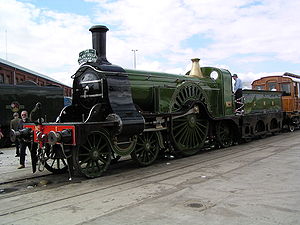 |
|
| LSWR London and South Western Railway The London and South Western Railway was a railway company in England from 1838 to 1922. Its network extended from London to Plymouth via Salisbury and Exeter, with branches to Ilfracombe and Padstow and via Southampton to Bournemouth and Weymouth. It also had many routes connecting towns in... |
30587 (BRThe Beattie Well tank was built by Beyer Peacock in 1874 for the London and South Western Railway. It initially carried the number 298 but this was later changed to 0298 in a duplicate series and was rebuilt at their Eastleigh Works Eastleigh Works Eastleigh Works is a locomotive, carriage and wagon building and repair facility in the town of Eastleigh in the county of Hampshire in England.-History under the LSWR:... in 1921. When it became the property of the Southern Railway it initially carried the number E0298 but this was changed to 3298. It is preserved in British Railways guise with its final number 30587. |
0298 Class LSWR 0298 Class The London and South Western Railway 0298 Class or Beattie Well Tank is a class of British steam locomotive. They are 2-4-0WT well tanks, originally built between 1863 and 1875 for use on passenger services in the suburbs of London, but later used on rural services in South West England... ("Beattie Well Tank") |
Beyer Peacock | 1412 | 1874 | 2-4-0WT | Bodmin Bodmin and Wenford Railway The Bodmin & Wenford Railway is a heritage railway, based at Bodmin in Cornwall, United Kingdom. It has an interchange with the national rail network at Bodmin Parkway railway station, the southern terminus of the line.-History:... |
1978-7018 | |
| Hebburn Works | 2 Bauxite | Black, Hawthorn Black, Hawthorn & Co Black, Hawthorn and Company was a steam locomotive manufacturer with a works situated in Gateshead, Tyne and Wear, UK.-John Coulthard and Son:... |
305 | 1874 | 0-4-0ST | York | 1953-354 | ||
| NER | 1275 | 1001 Class NER 1001 Class The North Eastern Railway 1001 Class was a class of "long-boiler" 0-6-0 steam locomotive designed in Britain.-Technical data:A NER 1001 class locomotive weighed about 35 tons, with a wheelbase of and diameter driven wheels. Its diameter boiler produced over 7 tons of tractive effort at 140... |
Dübs Dûbs and Company Dübs & Co. was a locomotive works in Glasgow, Scotland, founded by Henry Dübs in 1863 and based at the Queens Park Works in Polmadie. In 1903 it became part of the North British Locomotive Company.-Preserved locomotives:... |
708 | 1874 | 0-6-0 0-6-0 Under the Whyte notation for the classification of steam locomotives, 0-6-0 represents the wheel arrangement of no leading wheels, six powered and coupled driving wheels on three axles, and no trailing wheels... |
York | 1975-7009 | |
| NER | 910 | 901 Class NER 901 Class The NER 901 Class was a class of 2-4-0 steam locomotive of the North Eastern Railway. Between 1872-1882 55 of the class were built for the NER.... |
NER Gateshead | 1875 | 2-4-0 2-4-0 Under the Whyte notation for the classification of steam locomotives, 2-4-0 represents the wheel arrangement of two leading wheels on one axle, four powered and coupled driving wheels on two axles, and no trailing wheels.... |
Shildon | 1975-7004 | ||
| LBSCR London, Brighton and South Coast Railway The London, Brighton and South Coast Railway was a railway company in the United Kingdom from 1846 to 1922. Its territory formed a rough triangle, with London at its apex, practically the whole coastline of Sussex as its base, and a large part of Surrey... |
82 BoxhillBoxhill was originally numbered 82 but this was later changed to 682. On transfer to the Southern railway this became 380S in their Service Stock series. | A1 Class LB&SCR A1 Class The London, Brighton and South Coast Railway A1 Class is an English class of 0-6-0T steam locomotive. Designed by William Stroudley, 50 members of the class were built in 1872 and between 1874 and 1880, all at Brighton Works. The class have received several nicknames, initially being known as... |
LBSCR Brighton | 1880 | 0-6-0T | York | 1975-7012 | 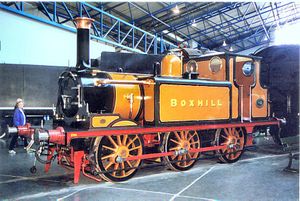 |
|
| LBSCR | 214 GladstoneGladstone was originally numberes 214 but was renumbered 618. Upon transfer to the Southern Railway this became B618. | B1 Class LB&SCR B1 Class The London, Brighton and South Coast Railway B1 Class is a class of 0-4-2 express passenger steam locomotives, known from the name of the first, No. 214, as the "Gladstones".-History:... |
LBSCR Brighton | 1882 | 0-4-2 0-4-2 Under the Whyte notation for the classification of steam locomotives, 0-4-2 represents the wheel arrangement with no leading wheels, four powered and coupled driving wheels on two axles, and two trailing wheels on one axle... |
York | 1975-7017 | ||
| NER | 1463 | 1463 Class NER 1463 Class The NER 1463 Class was a class of 2-4-0 steam locomotive of the North Eastern Railway. The class was designed in 1884 by a locomotive committee, chaired by Henry Tennant, and built in 1885.... |
NER Darlington Darlington Works Darlington railway works, known in the town as North Road Shops, was built in 1863 by the Stockton and Darlington Railway in the town of Darlington in the north east of England.-NER History:The first new locomotive was built at the works in 1864... |
1885 | 2-4-0 2-4-0 Under the Whyte notation for the classification of steam locomotives, 2-4-0 represents the wheel arrangement of two leading wheels on one axle, four powered and coupled driving wheels on two axles, and no trailing wheels.... |
Darlington | 1975-7020 | ||
| LYR Lancashire and Yorkshire Railway The Lancashire and Yorkshire Railway was a major British railway company before the 1923 Grouping. It was incorporated in 1847 from an amalgamation of several existing railways... |
1008Lancashire and Yorkshire Railway 1008 was numbered 10621 by the London Midland and Scottish Railway, and 50621 by British Railways. | Class 5 L&YR Class 5 The Lancashire and Yorkshire Railway Class 5 and Class 6 were two related classes of 2-4-2T steam locomotives.- Class 5 :The class began as a John Aspinall design of 1889. The first locomotives had 18"×26" cylinders for a tractive effort of 18,955 lb and power class 2P... |
LYR Horwich Horwich Works Horwich Works was a railway works built in 1886 by the Lancashire and Yorkshire Railway in Horwich, near Bolton, in the North West of England when the company moved from its original works at Miles Platting, Manchester.-Buildings:... |
1 | 1889 | 2-4-2T | York | 1976-7003 | |
| LNWR London and North Western Railway The London and North Western Railway was a British railway company between 1846 and 1922. It was created by the merger of three companies – the Grand Junction Railway, the London and Birmingham Railway and the Manchester and Birmingham Railway... |
790 HardwickeHardwicke was London North Western Railway 790 and then London Midland and Scottish Railway 5031. | Improved Precedent LNWR Improved Precedent Class The London and North Western Railway Improved Precedent Class or "Jumbo" Class is a class of 2-4-0 steam locomotive originally designed for express passenger work.... |
LNWR Crewe Crewe Works Crewe railway works is a British railway engineering facility built in 1840 by the Grand Junction Railway. It is located in the town of Crewe, in the county of Cheshire.... |
3286 | 1892 | 2-4-0 2-4-0 Under the Whyte notation for the classification of steam locomotives, 2-4-0 represents the wheel arrangement of two leading wheels on one axle, four powered and coupled driving wheels on two axles, and no trailing wheels.... |
York | 1975-7023 |  |
| S&MR | 1 Gazelle | Alfred Dodman & Co. | 1893 | 0-4-2WT | Tenterden | 1975-7010 | |||
| LSWR London and South Western Railway The London and South Western Railway was a railway company in England from 1838 to 1922. Its network extended from London to Plymouth via Salisbury and Exeter, with branches to Ilfracombe and Padstow and via Southampton to Bournemouth and Weymouth. It also had many routes connecting towns in... |
563London and South Western Railway 563 was numbered E563 by the Southern Railway and 30563 by British Railways. | T3 Class LSWR T3 class The LSWR T3 class was a class of express passenger 4-4-0 steam locomotives designed for the London and South Western Railway by William Adams. Twenty were constructed between 1892–1893.... |
LSWR Nine Elms Nine Elms Locomotive Works Nine Elms locomotive works were built in 1839 by the London and South Western Railway adjoining their passenger terminus near the Vauxhall end of Nine Elms Lane, in the district of Nine Elms in the London Borough of Battersea. They were rebuilt in 1841 and remained the principal locomotive... |
380 | 1893 | 4-4-0 4-4-0 Under the Whyte notation for the classification of steam locomotives, 4-4-0 represents the wheel arrangement of four leading wheels on two axles , four powered and coupled driving wheels on two axles, and no trailing wheels... |
Toronto Toronto Railway Heritage Centre The Toronto Railway Heritage Centre is a museum being developed by the Toronto Railway Historical Association in partnership with the City of Toronto in Ontario, Canada.-Mission:The mission of the Toronto Railway Heritage Centre is to:... |
1975-7000 | 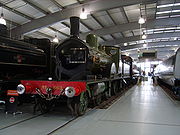 |
| NER | 1621 | M1 Class NER Class M1 The North Eastern Railway Class M1 is a class of 4-4-0 steam locomotive, designed by Wilson Worsdell. 20 initial engines were built, then 30 further units were built, designated Class Q .-Classification:... (LNER D17/1) |
NER Gateshead | 1893 | 4-4-0 4-4-0 Under the Whyte notation for the classification of steam locomotives, 4-4-0 represents the wheel arrangement of four leading wheels on two axles , four powered and coupled driving wheels on two axles, and no trailing wheels... |
York | 1975-7008 | ||
| GNR Great Northern Railway (Great Britain) The Great Northern Railway was a British railway company established by the Great Northern Railway Act of 1846. On 1 January 1923 the company lost its identity as a constituent of the newly formed London and North Eastern Railway.... |
1002 | Stirling Single | 1893 | Only the tender of Stirling Single 1002 survives. | York | 1978-7122 | |||
| GER Great Eastern Railway The Great Eastern Railway was a pre-grouping British railway company, whose main line linked London Liverpool Street to Norwich and which had other lines through East Anglia... |
GER 490 BR 62785T26 Class 490 was built for the Great Eastern Railway. The London and North Eastern Railway gave it the number 7490 in 1923 but later changed this to 2785, so for British Railways it was number 62785. |
T26 Class GER Class T26 The GER Class T26 was a class of 2-4-0 steam tender locomotives designed by James Holden for the Great Eastern Railway. At the 1923 grouping they passed to the London and North Eastern Railway, who classified them E4. Eighteen survived into British Railways ownership in 1948, and the last was... (LNER E4) |
GER Stratford Stratford Works Stratford Works was the locomotive-building works of the Great Eastern Railway situated at Stratford, London, England. It was opened in 1847-1848 by the GER's predecessor, the Eastern Counties Railway... |
836 | 1894 | 2-4-0 2-4-0 Under the Whyte notation for the classification of steam locomotives, 2-4-0 represents the wheel arrangement of two leading wheels on one axle, four powered and coupled driving wheels on two axles, and no trailing wheels.... |
Bressingham | 1975-7002 |  |
| LSWR | LSWR 245M7 Class 245 was numbered E245 by the Southern Railway but later reverted to plain 245; under British Railways ownership it carried number 30245. | M7 Class LSWR M7 Class The LSWR M7 class is a class of 0-4-4 passenger tank locomotive built between 1897 and 1911. The class was designed by Dugald Drummond for use on the intensive London network of the London and South Western Railway , and performed well in such tasks. Because of their utility, 105 were built and the... |
LSWR Nine Elms | — | 1897 | 0-4-4T | York | 1978-7020 | |
| GWR Great Western Railway The Great Western Railway was a British railway company that linked London with the south-west and west of England and most of Wales. It was founded in 1833, received its enabling Act of Parliament in 1835 and ran its first trains in 1838... |
2516 | 2301 Class GWR 2301 Class The Great Western Railway 2301 Class or Dean Goods Class is a class of British 0-6-0 steam locomotives.Swindon railway works built 260 of these goods locomotives between 1883 and 1899 to a design of William Dean... |
GWR Swindon Swindon Works Swindon railway works were built by the Great Western Railway in 1841 in Swindon in the English county of Wiltshire.-History:In 1835 Parliament approved the construction of a railway between London and Bristol. Its Chief Engineer was Isambard Kingdom Brunel.From 1836, Brunel had been buying... |
1557 | 1897 | 0-6-0 0-6-0 Under the Whyte notation for the classification of steam locomotives, 0-6-0 represents the wheel arrangement of no leading wheels, six powered and coupled driving wheels on three axles, and no trailing wheels... |
Swindon | 1978-7021 | 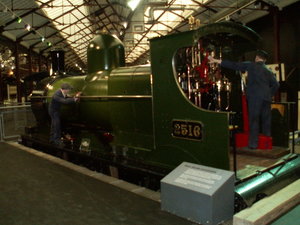 |
| TVR Taff Vale Railway The Taff Vale Railway is a railway in Glamorgan, South Wales, and is one of the oldest in Wales. It operated as an independent company from 1836 until 1922, when it became a constituent company of the Great Western Railway... |
TVR 28Taff Vale Railway number 28 became 450 in Great Western Railway ownership. | O1 Class Taff Vale Railway O1 class The Taff Vale Railway O1 class was a class of 0-6-2T steam tank locomotives designed by Tom Hurry Riches and introduced to the Taff Vale Railway in 1894.-Numbering:-Withdrawal and disposal:... |
TVR Cardiff | 306 | 1897 | 0-6-2T | Llangollen Llangollen Railway The Llangollen Railway is a volunteer-run preserved railway in Denbighshire, Wales, which operates between Llangollen and Carrog; at long, it is the longest preserved standard gauge line in Wales and operates daily in Summer as well as weekends throughout the Winter months using a wide variety of... |
1978-7022 | |
| GNR | 990 Henry OakleyHenry Oakley was renumbered 3990 by the London and North Eastern Railway. | Class C1 (LNER C2) |
GNR Doncaster Doncaster Works Doncaster railway works is in the town of Doncaster, South Yorkshire, England.Always referred to as "the Plant", it was established by the Great Northern Railway in 1853, replacing the previous works in Boston and Peterborough... |
708 | 1898 | 4-4-2 4-4-2 (locomotive) Under the Whyte notation for the classification of steam locomotives, 4-4-2 represents the wheel arrangement of four leading wheels on two axles , four powered and coupled driving wheels on two axles, and two trailing wheels on one axle... |
Bressingham | 1975-7001 | 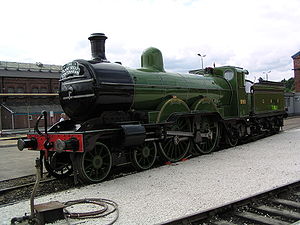 |
| MR Midland Railway The Midland Railway was a railway company in the United Kingdom from 1844 to 1922, when it became part of the London, Midland and Scottish Railway.... |
673Midland Railway 673 had earlier carried number 118. | 115 Class Midland Railway 115 Class The Midland Railway 115 Class is a class of 4-2-2 steam locomotive. They were known as "Spinners", possibly because of the wheelslip that the single large driving wheel caused. They were designed by Samuel W... |
MR Derby Derby Works The Midland Railway Locomotive Works, known locally as "the loco" comprised a number of British manufacturing facilities in Derby building locomotives and, initially, rolling stock in Derby, UK.-Early days:... |
1899 | 4-2-2 4-2-2 Under the Whyte notation for the classification of steam locomotives, 4-2-2 represents the wheel arrangement of four leading wheels on two axles, two powered driving wheels on one axle, and two trailing wheels on one axle.... |
York | 1978-7023 | 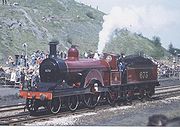 |
|
| GNR | 1247Great Northern Railway 1247 became 4247 under London and North Eastern Railway ownership. This was alter changed to 8846 so it became British Railway's 68846. | Class J13 GNR Class J13 The Great Northern Railway Class J13, classified J52 by the LNER is a class of 0-6-0ST steam locomotive intended primarily for shunting.... (LNER J52) |
Sharp Stewart | 4492 | 1899 | 0-6-0ST | Shildon | 1980-7001 | |
| LSWR | 120T9 number 120 became Southern Railway's E120 before reverting to 120. For British Railways it was renumbered 30120. | T9 Class | LSWR Nine Elms | — | 1899 | 4-4-0 4-4-0 Under the Whyte notation for the classification of steam locomotives, 4-4-0 represents the wheel arrangement of four leading wheels on two axles , four powered and coupled driving wheels on two axles, and no trailing wheels... |
Bodmin | 1978-7024 | |
Standard gauge designs 1900 to 1922
These locomotives are all gauge unless noted otherwise.| Railway | Number and name | Type or Class | Builder | Works Number |
Built | Wheels | Location | Object Number | Image |
|---|---|---|---|---|---|---|---|---|---|
| SECR South Eastern and Chatham Railway The South Eastern and Chatham Railway Companies Joint Management Committee , known by its shorter name of the South Eastern and Chatham Railway was a working union of two neighbouring rival railways, the South Eastern Railway and London, Chatham and Dover Railway , that operated services between... |
737South Eastern and Chatham Railway 737 became Southern Railway A737 before renumbering to 1737. Under British Railways it was number 31737. | D Class SECR D class The SECR D class was a class of 4-4-0 tender locomotives designed by Harry Wainwright for the South Eastern and Chatham Railway.-Overview:The construction of the initial 20 engines was shared between Ashford railway works and the Glasgow builder, Sharp, Stewart and Company. The first of the class... |
SECR Ashford | 1901 | 4-4-0 4-4-0 Under the Whyte notation for the classification of steam locomotives, 4-4-0 represents the wheel arrangement of four leading wheels on two axles , four powered and coupled driving wheels on two axles, and no trailing wheels... |
York National Railway Museum The National Railway Museum is a museum in York forming part of the British National Museum of Science and Industry and telling the story of rail transport in Britain and its impact on society. It has won many awards, including the European Museum of the Year Award in 2001... |
1975-7006 | ||
| MR Midland Railway The Midland Railway was a railway company in the United Kingdom from 1844 to 1922, when it became part of the London, Midland and Scottish Railway.... |
1000Midland Railway 1000 was originally numbered 2361. Under British Railways it was number 41000. | 1000 Class Midland Railway 1000 Class Midland Railway 1000 Class is a class of 4-4-0 steam locomotive designed for passenger work.-Overview:These were developed from a series of five locomotives introduced in 1902 by Samuel W... |
MR Derby Derby Works The Midland Railway Locomotive Works, known locally as "the loco" comprised a number of British manufacturing facilities in Derby building locomotives and, initially, rolling stock in Derby, UK.-Early days:... |
1902Midland Railway 1000 was rebuilt in 1914. | 4-4-0 4-4-0 Under the Whyte notation for the classification of steam locomotives, 4-4-0 represents the wheel arrangement of four leading wheels on two axles , four powered and coupled driving wheels on two axles, and no trailing wheels... |
Bo'ness Scottish Railway Preservation Society The Scottish Railway Preservation Society is a charity, whose principal objective is the preservation and advancement of railway heritage in Scotland. The Society was formed in 1961, and it has been actively collecting and displaying railway artifacts of Scottish significance ever since... |
1975-7018 | ||
| GNR Great Northern Railway (Great Britain) The Great Northern Railway was a British railway company established by the Great Northern Railway Act of 1846. On 1 January 1923 the company lost its identity as a constituent of the newly formed London and North Eastern Railway.... |
251Great Northern Railway 251 became London and North Eastern Railway 3251 before renumbering to 2800. | C1 Class GNR Class C1 The Great Northern Railway Class C1 is a type of 4-4-2 steam locomotive. One, ex GNR 251, later LNER 2800, survives in preservation.- Development :... |
GNR Doncaster Doncaster Works Doncaster railway works is in the town of Doncaster, South Yorkshire, England.Always referred to as "the Plant", it was established by the Great Northern Railway in 1853, replacing the previous works in Boston and Peterborough... |
991 | 1902 | 4-4-0 4-4-0 Under the Whyte notation for the classification of steam locomotives, 4-4-0 represents the wheel arrangement of four leading wheels on two axles , four powered and coupled driving wheels on two axles, and no trailing wheels... |
Bressingham | 1975-7005 | |
| GWR Great Western Railway The Great Western Railway was a British railway company that linked London with the south-west and west of England and most of Wales. It was founded in 1833, received its enabling Act of Parliament in 1835 and ran its first trains in 1838... |
GWR 3440 City of Truro GWR 3700 Class 3440 City of Truro Number 3440 City Of Truro is a Great Western Railway 3700 Class 4-4-0 locomotive, designed by George Jackson Churchward and built at the GWR Swindon Works in 1903. . It is one of the contenders for the first steam locomotive to travel in excess of... City of Truro carried number 3717 for a time. |
3700 Class ("City") GWR 3700 Class The Great Western Railway 3700 Class, or City Class, locomotives were a series of twenty 4-4-0 steam locomotives, designed for hauling express passenger trains.-Construction:... |
GWR Swindon Swindon Works Swindon railway works were built by the Great Western Railway in 1841 in Swindon in the English county of Wiltshire.-History:In 1835 Parliament approved the construction of a railway between London and Bristol. Its Chief Engineer was Isambard Kingdom Brunel.From 1836, Brunel had been buying... |
2000 | 1903 | 4-4-0 4-4-0 Under the Whyte notation for the classification of steam locomotives, 4-4-0 represents the wheel arrangement of four leading wheels on two axles , four powered and coupled driving wheels on two axles, and no trailing wheels... |
Toddington Gloucestershire Warwickshire Railway The Gloucestershire Warwickshire Railway is a volunteer-run heritage railway on the Gloucestershire/Worcestershire/Warwickshire Borders that has reopened the closed railway line between Laverton Halt and Cheltenham Racecourse railway stations in Gloucestershire/Worcestershire., it currently... |
1978-7025 | |
| GER Great Eastern Railway The Great Eastern Railway was a pre-grouping British railway company, whose main line linked London Liverpool Street to Norwich and which had other lines through East Anglia... |
87Great Eastern Railway 877 became London and North Eastern Railway 7087 before renumbering to 8633. Under British Railways it was number 68633. | S56 Class (LNER J69) |
GER Stratford Stratford Works Stratford Works was the locomotive-building works of the Great Eastern Railway situated at Stratford, London, England. It was opened in 1847-1848 by the GER's predecessor, the Eastern Counties Railway... |
1249 | 1904 | 0-6-0T | York | 1975-7003 | |
| GER | 1217Great Eastern Railway 1217 became London and North Eastern Railway 8217 before renumbering to 5567. Under British Railways it was number 65567. | G58 Class GER Class G58 The GER Class G58 was a class of 0-6-0 steam tender locomotives designed by James Holden for the Great Eastern Railway. The class consisted partly of new locomotives built 1905–1911 and partly of rebuilds of the earlier GER Class F48, originally built 1900–1903... (LNER J17) |
GER Stratford | 1905 | 0-6-0 0-6-0 Under the Whyte notation for the classification of steam locomotives, 0-6-0 represents the wheel arrangement of no leading wheels, six powered and coupled driving wheels on three axles, and no trailing wheels... |
Barrow Hill Barrow Hill Engine Shed Barrow Hill Roundhouse & Railway Centre, until 1948 known as Staveley Roundhouse & Train Centre, is a former Midland Railway roundhouse in Barrow Hill, near Staveley and Chesterfield, Derbyshire .-History:... |
1978-7026 | ||
| GWR | 2818 | 2800 Class GWR 2800 Class The Great Western Railway 2800 Class is a class of steam locomotive designed by G.J. Churchward for heavy freight work. They were the first 2-8-0 class in Great Britain.... |
GWR Swindon | 2122 | 1905 | 2-8-0 2-8-0 Under the Whyte notation for the classification of steam locomotives, 2-8-0 represents the wheel arrangement of two leading wheels on one axle , eight powered and coupled driving wheels on four axles, and no trailing wheels... |
York | 1976-7001 | |
| GWR | GWR 4003 Lode Star GWR 4000 Class 4003 Lode Star Lode Star is the only remaining GWR 4000 Class locomotive. It is preserved at the National Railway Museum, York, UK.Lode Star was designed by George Jackson Churchward and was built in 1907, one of the first locomotives in its class to be built.... |
4000 Class ("Saint") GWR 4000 Class A Star class locomotive was a particular type of steam locomotive of the Great Western Railway. The prototype was an experimental locomotive, North Star , constructed with the 'Atlantic' 4-4-2 wheel arrangement for comparative trials with 4-cylinder compound locomotives of the de Glehn type that... |
Swindon Works Swindon Works Swindon railway works were built by the Great Western Railway in 1841 in Swindon in the English county of Wiltshire.-History:In 1835 Parliament approved the construction of a railway between London and Bristol. Its Chief Engineer was Isambard Kingdom Brunel.From 1836, Brunel had been buying... |
2231 | 1907 | 4-6-0 4-6-0 Under the Whyte notation for the classification of steam locomotives, 4-6-0 represents the wheel arrangement of four leading wheels on two axles in a leading truck, six powered and coupled driving wheels on three axles, and no trailing wheels. This wheel arrangement became the second-most popular... |
Swindon Swindon Steam Railway Museum STEAM – Museum of the Great Western Railway, also known as Swindon Steam Railway Museum, is located at the site of the old railway works in Swindon, England – Wiltshire's 'railway town'... |
1978-7027 | |
| LTSR London, Tilbury and Southend Railway The London, Tilbury and Southend Railway is an English railway line linking Fenchurch Street railway station in the City of London with northeast London and the entire length of the northern Thames Gateway area of southern Essex. It is currently known as the Essex Thameside Route by Network Rail... |
80 Thundersley80 Thundersley became Midland Railway 2177. It retained this number with the London Midland and Scottish Railway but was later renumbered to 2148. Under British Railways it was number 41966. | 79 Class LT&SR 79 Class The London, Tilbury and Southend Railway 79 Class is a class of 4-4-2T suburban tank engines. They were designed by Thomas Whitelegg, as a development of the earlier 37 Class.... |
Stephenson Robert Stephenson and Company Robert Stephenson and Company was a locomotive manufacturing company founded in 1823. It was the first company set up specifically to build railway engines.- Foundation and early success :... |
3367 | 1909 | 4-4-2T | Bressingham | 1978-7028 | |
| Longmoor Longmoor Military Railway The Longmoor Military Railway was a British military railway in Hampshire, built by the Royal Engineers from 1903 in order to train soldiers on railway construction and operations.-Route:... |
Woolmer | Avonside Avonside Engine Company The Avonside Engine Company was a locomotive manufacturer in Avon Street, St. Philip's, Bristol, England between 1864 and 1934. However the business originated with an earlier enterprise Henry Stothert and Company.-Origins:... |
1572 | 1910 | 0-6-0ST | Basingstoke Milestones Museum Milestones Museum is a museum located in Basingstoke, Hampshire, UK. It is made up of a network of streets that have been recreated on those found in Victorian and 1930s Hampshire.... |
2008-7159 | ||
| GCR Great Central Railway The Great Central Railway was a railway company in England which came into being when the Manchester, Sheffield and Lincolnshire Railway changed its name in 1897 in anticipation of the opening in 1899 of its London Extension . On 1 January 1923, it was grouped into the London and North Eastern... |
63601 (BR)63601 was originally Great Central Railway 102. It became London and North Eastern Railway 5102 before renumbering to 3509. | 8K Class GCR Class 8K The Great Central Railway Class 8K 2-8-0 is a class of steam locomotive designed for heavy freight. Introduced in 1911, and designed by John G. Robinson, 126 were built for the GCR prior to the First World War... (LNER O4) |
GCR Gorton Gorton locomotive works Gorton Locomotive Works, known locally as Gorton Tank was located in Openshaw near Manchester, England and was completed in 1848 by the Sheffield, Ashton-under-Lyne and Manchester Railway.- History :... |
1911 | 2-8-0 2-8-0 Under the Whyte notation for the classification of steam locomotives, 2-8-0 represents the wheel arrangement of two leading wheels on one axle , eight powered and coupled driving wheels on four axles, and no trailing wheels... |
GCR Great Central Railway (preserved) The Great Central Railway is a heritage railway split into two adjacent sections, one in Leicestershire and the other Nottinghamshire.The Leicestershire section is currently Britain's only double track mainline heritage railway, with of working double track, period signalling, locomotives and... |
1975-7027 | 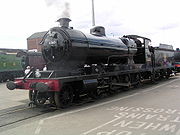 |
|
| NER North Eastern Railway (UK) The North Eastern Railway , was an English railway company. It was incorporated in 1854, when four existing companies were combined, and was absorbed into the London and North Eastern Railway at the Grouping in 1923... |
901North Eastern Railway 901 retained its number with the London and North Eastern Railway for many years but was eventually renumbered as 3460. Under British Railways it was number 63460. | T3 Class NER Class T3 North Eastern Railway Class T3, classified Q7 by the LNER is a class of 0-8-0 steam locomotive designed for heavy freight. Five were built by the NER in 1919 and a further 10 by the London and North Eastern Railway in 1924.-Performance:... (LNER Q7) |
NER Darlington Darlington Works Darlington railway works, known in the town as North Road Shops, was built in 1863 by the Stockton and Darlington Railway in the town of Darlington in the north east of England.-NER History:The first new locomotive was built at the works in 1864... |
1919 | 0-8-0 0-8-0 Under the Whyte notation for the classification of steam locomotives, 0-8-0 represents the wheel arrangement of no leading wheels, eight powered and coupled driving wheels on four axles, and no trailing wheels... |
Darlington | 1978-7029 | ||
| GCR | 506 Butler HendersonButler Henderson became London and North Eastern Railway 5506 before being renumbered as 2660. Under British Railways it was number 62712. | 11F Class GCR Class 11F The Great Central Railway Class 11F or Improved Director Class is a class of 4-4-0 steam locomotive designed by John G. Robinson for passenger work. The LNER classified them as Class D11 from 1923... (LNER D11) |
GCR Gorton | 1920 | 4-4-0 4-4-0 Under the Whyte notation for the classification of steam locomotives, 4-4-0 represents the wheel arrangement of four leading wheels on two axles , four powered and coupled driving wheels on two axles, and no trailing wheels... |
Barrow Hill | 1978-7030 | 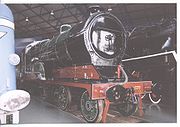 |
|
| LNWR London and North Western Railway The London and North Western Railway was a British railway company between 1846 and 1922. It was created by the merger of three companies – the Grand Junction Railway, the London and Birmingham Railway and the Manchester and Birmingham Railway... |
49395 (BR)49395 was originally London and North Western Railway 485, later Midland Railway 9395. | G Class ("Super D" LNWR G Class The London and North Western Railway G Class along with modifications that made them into G1, G2 and G2a classes, is a class of 0-8-0 steam locomotives designed for heavy freight work. They are known to railway enthusiasts as "Super Ds". This is because a large number of G1 class engines were... |
LNWR Crewe Crewe Works Crewe railway works is a British railway engineering facility built in 1840 by the Grand Junction Railway. It is located in the town of Crewe, in the county of Cheshire.... |
5662 | 1921 | 0-8-0 0-8-0 Under the Whyte notation for the classification of steam locomotives, 0-8-0 represents the wheel arrangement of no leading wheels, eight powered and coupled driving wheels on four axles, and no trailing wheels... |
NYMR North Yorkshire Moors Railway The North Yorkshire Moors Railway is a heritage railway in North Yorkshire, England. First opened in 1836 as the Whitby and Pickering Railway, the railway was planned in 1831 by George Stephenson as a means of opening up trade routes inland from the then important seaport of Whitby. The line... |
1978-7031 | |
| NSR North Staffordshire Railway The North Staffordshire Railway was a British railway company formed in 1845 to promote a number of lines in the Staffordshire Potteries and surrounding areas in Staffordshire, Cheshire, Derbyshire and Shropshire.... |
2North Staffordshire Railway number 2 was later London Midland and Scottish Railway number 2271. It was then sold to Manchester Collieries Manchester Collieries Manchester Collieries was a coal mining company formed in 1929 with headquarters at Walkdenfrom a group of independent companies operating on the Manchester Coalfield. The Mining Industry Act of 1926 attempted to stem the post-war decline in coal mining and encourage independent companies to merge... where it was their number 2. |
L Class | NSR Stoke Stoke railway works Stoke railway works was set up in 1864 by the North Staffordshire Railway in the city of Stoke-on-Trent in the county of Staffordshire, England.... |
1922 | 0-6-2T | Shildon | 1978-7032 | ||
Standard gauge designs 1923 to 1947
These locomotives are all gauge unless noted otherwise.| Railway | Number and name | Type or Class | Builder | Works Number |
Built | Wheels | Location | Object Number | Image |
|---|---|---|---|---|---|---|---|---|---|
| GWR Great Western Railway The Great Western Railway was a British railway company that linked London with the south-west and west of England and most of Wales. It was founded in 1833, received its enabling Act of Parliament in 1835 and ran its first trains in 1838... |
4073 Caerphilly Castle GWR 4073 Class 4073 Caerphilly Castle Caerphilly Castle is a member of the GWR 4073 Class built in 1923. Its first shed allocation was Old Oak Common. Its August 1950 shed allocation was Bath Road, Bristol. Its last shed allocation was Cardiff Canton in March 1959... |
4073 Class ("Castle") GWR 4073 Class The GWR 4073 Class or Castle class locomotives are a group of 4-6-0 steam locomotives of the Great Western Railway. They were originally designed by the railway's Chief Mechanical Engineer, Charles Collett, for working the company's express passenger trains.-History:A development of the earlier... |
GWR Swindon Swindon Works Swindon railway works were built by the Great Western Railway in 1841 in Swindon in the English county of Wiltshire.-History:In 1835 Parliament approved the construction of a railway between London and Bristol. Its Chief Engineer was Isambard Kingdom Brunel.From 1836, Brunel had been buying... |
1923 | 4-6-0 4-6-0 Under the Whyte notation for the classification of steam locomotives, 4-6-0 represents the wheel arrangement of four leading wheels on two axles in a leading truck, six powered and coupled driving wheels on three axles, and no trailing wheels. This wheel arrangement became the second-most popular... |
Swindon Swindon Steam Railway Museum STEAM – Museum of the Great Western Railway, also known as Swindon Steam Railway Museum, is located at the site of the old railway works in Swindon, England – Wiltshire's 'railway town'... |
1961-76 | 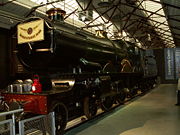 |
|
| LNER London and North Eastern Railway The London and North Eastern Railway was the second-largest of the "Big Four" railway companies created by the Railways Act 1921 in Britain... |
4472 Flying Scotsman LNER Class A3 4472 Flying Scotsman The LNER Class A3 Pacific locomotive No. 4472 Flying Scotsman was built in 1923 for the London and North Eastern Railway at Doncaster Works to a design of H.N. Gresley... Flying Scotsman was originally numbered 4472 but later carried the numbers 502 then 103. British Railways numbered it 60103. |
A3 Class LNER Gresley Classes A1 and A3 The London and North Eastern Railway LNER Gresley Classes A1 and A3 locomotives represented two distinct stages in the history of the British 4-6-2 "Pacific" steam locomotives designed by Nigel Gresley... |
LNER Doncaster Doncaster Works Doncaster railway works is in the town of Doncaster, South Yorkshire, England.Always referred to as "the Plant", it was established by the Great Northern Railway in 1853, replacing the previous works in Boston and Peterborough... |
1564 | 1923 | 4-6-2 4-6-2 4-6-2, in the Whyte notation for the classification of steam locomotives, represents the wheel arrangement of four leading wheels on two axles , six powered and coupled driving wheels on three axles, and two trailing wheels on one axle .These locomotives are also known as Pacifics... |
York National Railway Museum The National Railway Museum is a museum in York forming part of the British National Museum of Science and Industry and telling the story of rail transport in Britain and its impact on society. It has won many awards, including the European Museum of the Year Award in 2001... |
2004-7103 |  |
| LMS London, Midland and Scottish Railway The London Midland and Scottish Railway was a British railway company. It was formed on 1 January 1923 under the Railways Act of 1921, which required the grouping of over 120 separate railway companies into just four... |
4027LMS 4027 was numbered 44027 by British Railways. | 4F LMS Fowler Class 4F The London Midland and Scottish Railway Fowler 4F is a class of 0-6-0 steam locomotive designed for medium freight work. They represent the ultimate development of Midland Railway's six coupled tender engines.- Background :... |
LMS Derby Derby Works The Midland Railway Locomotive Works, known locally as "the loco" comprised a number of British manufacturing facilities in Derby building locomotives and, initially, rolling stock in Derby, UK.-Early days:... |
— | 1924 | 0-6-0 0-6-0 Under the Whyte notation for the classification of steam locomotives, 0-6-0 represents the wheel arrangement of no leading wheels, six powered and coupled driving wheels on three axles, and no trailing wheels... |
Toddington Gloucestershire Warwickshire Railway The Gloucestershire Warwickshire Railway is a volunteer-run heritage railway on the Gloucestershire/Worcestershire/Warwickshire Borders that has reopened the closed railway line between Laverton Halt and Cheltenham Racecourse railway stations in Gloucestershire/Worcestershire., it currently... |
1978-7033 | |
| SR Southern Railway (Great Britain) The Southern Railway was a British railway company established in the 1923 Grouping. It linked London with the Channel ports, South West England, South coast resorts and Kent... |
777 Sir LamielSir lamiel was numbered 30777 by British Railways. | N15 Class LSWR N15 Class The LSWR N15 class was a British 2–cylinder 4-6-0 express passenger steam locomotive designed by Robert W. Urie. The class has a complex build history spanning three sub-classes and eight years of construction from 1919 to 1926... |
North British North British Locomotive Company The North British Locomotive Company was created in 1903 through the merger of three Glasgow locomotive manufacturing companies; Sharp Stewart and Company , Neilson, Reid and Company and Dübs and Company , creating the largest locomotive manufacturing company in Europe.Its main factories were... |
23223 | 1925 | 4-6-0 4-6-0 Under the Whyte notation for the classification of steam locomotives, 4-6-0 represents the wheel arrangement of four leading wheels on two axles in a leading truck, six powered and coupled driving wheels on three axles, and no trailing wheels. This wheel arrangement became the second-most popular... |
Loughborough Great Central Railway (preserved) The Great Central Railway is a heritage railway split into two adjacent sections, one in Leicestershire and the other Nottinghamshire.The Leicestershire section is currently Britain's only double track mainline heritage railway, with of working double track, period signalling, locomotives and... |
1978-7034 | |
| LMS | 13000LMS 13000 was later numbered 2700 and then in British Railways ownership it became 42700. | 5MT ("Crab") LMS Hughes Crab The London Midland and Scottish Railway Hughes Crab or Horwich Mogul is a class of mixed traffic 2-6-0 steam locomotive built between 1926 and 1932. They are noted for their appearance with large highly-angled cylinders caused by restricted loading gauge... |
LMS Horwich Horwich Works Horwich Works was a railway works built in 1886 by the Lancashire and Yorkshire Railway in Horwich, near Bolton, in the North West of England when the company moved from its original works at Miles Platting, Manchester.-Buildings:... |
— | 1926 | 2-6-0 2-6-0 Under the Whyte notation for the classification of steam locomotives, 2-6-0 represents the wheel arrangement of two leading wheels on one axle, usually in a leading truck, six powered and coupled driving wheels on three axles, and no trailing wheels. This arrangement is commonly called a Mogul... |
Shildon Shildon Locomotion Museum Shildon Locomotion Museum is a railway museum in Shildon, County Durham, England. The museum is a branch of the National Railway Museum , which is part of the National Museum of Science and Industry... |
1978-7036 | |
| SR | 850 Lord NelsonLord nelson was numbered 30850 by British Railways. | Lord Nelson SR Lord Nelson Class The SR class LN or Lord Nelson class is a type of 4-cylinder 4-6-0 steam locomotive designed for the Southern Railway by Richard Maunsell in 1926. They were intended for Continental boat trains between London and Dover harbour, but were also later used for express passenger work to the South-West... |
SR Easteligh Eastleigh Works Eastleigh Works is a locomotive, carriage and wagon building and repair facility in the town of Eastleigh in the county of Hampshire in England.-History under the LSWR:... |
— | 1926 | 4-6-0 4-6-0 Under the Whyte notation for the classification of steam locomotives, 4-6-0 represents the wheel arrangement of four leading wheels on two axles in a leading truck, six powered and coupled driving wheels on three axles, and no trailing wheels. This wheel arrangement became the second-most popular... |
Alresford | 1978-7035 |  |
| GWR | 6000 King George V GWR 6000 Class 6000 King George V thumb|right|6000 King George V at Swindon having just hauled the last King-hauled train from Wolverhampton and Birmingham Snow Hill . Note the bell which was given to the engine when it toured the U.S... |
6000 Class ("King") GWR 6000 Class The Great Western Railway 6000 Class or King is a class of 4-6-0 steam locomotive designed for express passenger work. With the exception of one Pacific , they were the largest locomotives the GWR built. They were named after kings of the United Kingdom and of England, beginning with the reigning... |
GWR Swindon | 1927 | 4-6-0 4-6-0 Under the Whyte notation for the classification of steam locomotives, 4-6-0 represents the wheel arrangement of four leading wheels on two axles in a leading truck, six powered and coupled driving wheels on three axles, and no trailing wheels. This wheel arrangement became the second-most popular... |
York | 1978-7037 | ||
| SR | 925 CheltemhamCheltenham was numbered 30925 by British Railways. | V ("Schools") | SR Eastleigh | — | 1934 | 4-4-0 4-4-0 Under the Whyte notation for the classification of steam locomotives, 4-4-0 represents the wheel arrangement of four leading wheels on two axles , four powered and coupled driving wheels on two axles, and no trailing wheels... |
Alresford | 1978-7038 | |
| LMS | 2500LMS 2500 was numbered 42500 by British Railways. | 2MT LMS 3-Cylindered Stanier 2-6-4T LMS 3-Cylindered Stanier 2-6-4T is a class of steam locomotive designed for work over the London, Tilbury and Southend Railway. All 2500-36 were built in 1934 at Derby Works. The third cylinder was provided to allow increased acceleration between the many stops on the L.T.&S.R. line. From 1935 the... |
LMS Derby | — | 1934 | 2-6-4T | York | 1978-7039 | |
| Chinese Government Railways China Railways China Railways is the national railway operator of the People's Republic of China, under the Chinese Ministry of Railways.China Railways operates rail commuter and freight transport via several smaller companies.... |
KF7Chineese Government Railways KF7 was renumbered 607. | KF1 Class | Vulcan Vulcan Foundry Vulcan Foundry was a British locomotive builder sited at Newton-le-Willows, Lancashire .-History:It was originally opened in 1832 as Charles Tayleur and Company to produce girders for bridges, switches and crossings, and other ironwork following the opening of the Liverpool and Manchester Railway... |
4674 | 1935 | 4-8-4 4-8-4 Under the Whyte notation classification of steam locomotives, 4-8-4 represents the wheel arrangement of four leading wheels on two axles , eight powered and coupled driving wheels on four axles, and four trailing wheels on two axles .Other equivalent classifications are:UIC classification: 2D2... |
York | 1987-7001 |  |
| LMS | 5000 LMS Stanier Class 5 4-6-0 5000 LMS Stanier Class 5 4-6-0 number 5000 is a preserved British steam locomotive. It is part of the National Railway Collection.- Service :5000 was built at Crewe in 1935 and was initially the first numerically of its class. It however was not the first to be built because the Vulcan Foundry had... LMS 5000 was numbered 45000 by British Railways. |
5MT LMS Stanier Class 5 4-6-0 The London Midland and Scottish Railway's Class 5 4-6-0, almost universally known as the Black Five, is a class of steam locomotive. It was introduced by William Stanier in 1934 and 842 were built between then and 1951... |
LMS Crewe | 216 | 1935 | 4-6-0 4-6-0 Under the Whyte notation for the classification of steam locomotives, 4-6-0 represents the wheel arrangement of four leading wheels on two axles in a leading truck, six powered and coupled driving wheels on three axles, and no trailing wheels. This wheel arrangement became the second-most popular... |
York | 1978-7040 | |
| LNER | 4771 Green Arrow LNER Class V2 4771 Green Arrow The LNER Class V2 2-6-2 steam locomotive, number 4771 Green Arrow was built in June 1936 for the London and North Eastern Railway at Doncaster Works to a design of Nigel Gresley. The first-built and only surviving member of its class, it was designed for hauling express freight and passenger... Green Arrow was originally numbered 4771 but later carried number 800 before becoming British Railways' 60800. |
V2 Class LNER Class V2 The London and North Eastern Railway Class V2 2-6-2 steam locomotives were designed by Sir Nigel Gresley for express mixed traffic work, and built between 1936–1944. The best known is the first of the class, 4771 Green Arrow, which is the only preserved example.-Construction:The V2s were the only... |
LNER Doncaster | 1837 | 1936 | 2-6-2 2-6-2 Under the Whyte notation for the classification of steam locomotives, 2-6-2 represents the wheel arrangement of two leading wheels, six coupled driving wheels and two trailing wheels.Other equivalent classifications are:... |
York | 1975-7025 | |
| LNER | 4468 Mallard LNER Class A4 4468 Mallard Number 4468 Mallard is a London and North Eastern Railway Class A4 4-6-2 Pacific steam locomotive built at Doncaster, England in 1938. While in other respects a relatively typical member of its class, it is historically significant for being the holder of the official world speed record for steam... Mallard was originally number 4468 but was renumbered as 22 before becoming British Railways' 60022. |
A4 Class LNER Class A4 The Class A4 is a class of streamlined 4-6-2 steam locomotive, designed by Nigel Gresley for the London and North Eastern Railway in 1935. Their streamlined design gave them high-speed capability as well as making them instantly recognizable, and one of the class, 4468 Mallard, still claims the... |
LNER Doncaster | 1870 | 1938 | 4-6-2 4-6-2 4-6-2, in the Whyte notation for the classification of steam locomotives, represents the wheel arrangement of four leading wheels on two axles , six powered and coupled driving wheels on three axles, and two trailing wheels on one axle .These locomotives are also known as Pacifics... |
Shildon | 1975-7007 |  |
| LMS | 6229 Duchess of Hamilton LMS Princess Coronation Class 6229 Duchess of Hamilton London Midland and Scottish Railway Princess Coronation Class 6229 Duchess of Hamilton is a preserved steam locomotive.- Service :... Duchess of Hamilton was numbered 46229 by British Railways. |
"Princess Coronation" LMS Princess Coronation Class The London Midland and Scottish Railway Coronation Class is a class of express passenger steam locomotives designed by William Stanier. They were an enlarged version of the LMS Princess Royal Class. Several examples were originally built as streamlined, though this was later removed... |
LMS Crewe | — | 1938 | 4-6-2 4-6-2 4-6-2, in the Whyte notation for the classification of steam locomotives, represents the wheel arrangement of four leading wheels on two axles , six powered and coupled driving wheels on three axles, and two trailing wheels on one axle .These locomotives are also known as Pacifics... |
York | 1976-7000 | |
| SR] | C1The Q1 Class 0-6-0 carried the number C1 when built but was numbered 33001 by British Railways. | Q1 | SR Brighton | 1942 | 0-6-0 0-6-0 Under the Whyte notation for the classification of steam locomotives, 0-6-0 represents the wheel arrangement of no leading wheels, six powered and coupled driving wheels on three axles, and no trailing wheels... |
York | 1978-7041 | ||
| CEGB | Eustace Forth | Robert Stephenson and Hawthorns Robert Stephenson and Hawthorns Robert Stephenson and Hawthorns Ltd was a locomotive builder with works in North East England.-History:The company was formed in September 1937 when Robert Stephenson and Company, which was based in Darlington took over the locomotive building department of Hawthorn Leslie and Company, based in... |
7063 | 1942 | 0-4-0ST | Shildon | 1978-7007 | ||
| WD War Department (UK) The War Department was the United Kingdom government department responsible for the supply of equipment to the armed forces of the United Kingdom and the pursuance of military activity. In 1857 it became the War Office... |
King Feisal of Iraq | Hunslet Hunslet Engine Company The Hunslet Engine Company is a British locomotive-building company founded in 1864 at Jack Lane, Hunslet, Leeds, West Yorkshire, England by John Towlerton Leather, a civil engineering contractor, who appointed James Campbell as his Works Manager.In 1871, James Campbell bought the company for... |
3183 | 1944 | 0-6-0ST | 0-6-0ST King Feisal of Iraq is currently at the Flour Mills Workshops in Bream, Gloucestershire Bream, Gloucestershire Bream is a village in the Forest of Dean, west Gloucestershire, England.-History:The actual age of Bream is not known, although there may have been a settlement before the Romans came to Britain... for overhaul. |
2005-7287 | ||
| SR | 34051 Winston Churchill SR Battle of Britain class 21C151 Winston Churchill 21C151 Winston Churchill is a Southern Railway Battle of Britain class 4-6-2 Pacific steam locomotive that has been preserved as part of the United Kingdom's National Collection. It is on display at the National Railway Museum.-Career:... Sir Winston Churchill was numbered 21C151 by the Southern Railway and 34051 by British Railways. |
Battle of Britain | SR Brighton | 1946 | 4-6-2 4-6-2 4-6-2, in the Whyte notation for the classification of steam locomotives, represents the wheel arrangement of four leading wheels on two axles , six powered and coupled driving wheels on three axles, and two trailing wheels on one axle .These locomotives are also known as Pacifics... |
York | 1978-7042 | ||
| GWR | 9400 | 9400 Class GWR 9400 Class The Great Western Railway 9400 Class is a class of 0-6-0 pannier tank steam locomotive, used for shunting and banking duties.The first ten 9400s were the last steam engines built by the GWR. After nationalisation in 1948, another 200 were built by private contractors for British Railways... |
GWR Swindon Works | 1947 | 0-6-0PT 0-6-0PT The GWR 0-6-0PT , is a type of steam locomotive built by the Great Western Railway with the water tanks carried on both sides of the boiler, in the manner of panniers. They were used for local, suburban and branch line passenger and goods traffic, for shunting duties, and as banker engines on... |
Swindon | 1978-7043 |  |
|
| BR (SR) Southern Region of British Railways The Southern Region was a region of British Railways from 1948. The region ceased to be an operating unit in its own right in the 1980s and was wound up at the end of 1992. The region covered south London, southern England and the south coast, including the busy commuter belt areas of Kent, Sussex... Ellerman Lines was built by British Railways to an earlier Southern Railway design. It has has been sectioned to show its construction. |
35029 Ellerman Lines | Merchant Navy SR Merchant Navy class The SR Merchant Navy class , was a class of air-smoothed 4-6-2 Pacific steam locomotives designed for the Southern Railway of the United Kingdom by Oliver Bulleid... |
SR Eastleigh | 1949 | 4-6-2 4-6-2 4-6-2, in the Whyte notation for the classification of steam locomotives, represents the wheel arrangement of four leading wheels on two axles , six powered and coupled driving wheels on three axles, and two trailing wheels on one axle .These locomotives are also known as Pacifics... |
York | 1975-7021 | ||
Standard gauge designs from 1948 onwards
These locomotives are all gauge unless noted otherwise.| Railway | Number | Type or Class | Builder | Works Number |
Built | Wheels | Location | Object Number | Image |
|---|---|---|---|---|---|---|---|---|---|
| BR | 70013 Oliver Cromwell BR standard class 7 70013 Oliver Cromwell 70013 Oliver Cromwell is a British Railways standard class 7 preserved steam locomotive. The locomotive is notable as one of the four steam locomotives which worked the last steam railtour on British Railways in 1968 before the introduction of a steam ban.-Career:One of 55 of the "Britannia"... |
7MT ("Britannia") BR standard class 7 The BR Standard Class 7, otherwise known as the Britannia Class, is a class of 4-6-2 Pacific steam locomotive designed by Robert Riddles for use by British Railways for mixed traffic duties. Fifty-five were constructed between 1951 and 1954. The design was a result of the 1948 locomotive exchanges... |
BR Crewe Crewe Works Crewe railway works is a British railway engineering facility built in 1840 by the Grand Junction Railway. It is located in the town of Crewe, in the county of Cheshire.... |
1951 | 4-6-2 4-6-2 4-6-2, in the Whyte notation for the classification of steam locomotives, represents the wheel arrangement of four leading wheels on two axles , six powered and coupled driving wheels on three axles, and two trailing wheels on one axle .These locomotives are also known as Pacifics... |
Loughborough Great Central Railway (preserved) The Great Central Railway is a heritage railway split into two adjacent sections, one in Leicestershire and the other Nottinghamshire.The Leicestershire section is currently Britain's only double track mainline heritage railway, with of working double track, period signalling, locomotives and... |
1978-7044 | 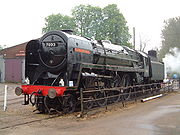 |
|
| IndustrialThe Barclay fireless locomotive was owned by Imperial Paper Mills. | 1 | Barclay | 2373 | 1956 | 0-4-0 0-4-0 Under the Whyte notation for the classification of steam locomotives, 0-4-0 represents one of the simplest possible types, that with two axles and four coupled wheels, all of which are driven... F |
Shildon Shildon Locomotion Museum Shildon Locomotion Museum is a railway museum in Shildon, County Durham, England. The museum is a branch of the National Railway Museum , which is part of the National Museum of Science and Industry... |
1978-7045 | ||
| IndustrialFrank Galbraith was owned by the Teesside Bridge and Engineering Company. | 5 Frank Galbraith | Sentinel Sentinel Waggon Works Sentinel Waggon Works Ltd was a British company based in Shrewsbury, Shropshire that made steam-powered lorries, railway locomotives, and later, diesel engined lorries and locomotives.-Alley & MacLellan, Sentinel Works, Jessie Street Glasgow:... |
9629 | 1957 | 0-4-0 VBT | York National Railway Museum The National Railway Museum is a museum in York forming part of the British National Museum of Science and Industry and telling the story of rail transport in Britain and its impact on society. It has won many awards, including the European Museum of the Year Award in 2001... |
1981-7000 | ||
| BR | 92220 Evening Star BR standard class 9F 92220 Evening Star British Railways Standard Class 9F number 92220 Evening Star, is a preserved British steam locomotive completed in 1960. It was the last steam locomotive to be built by British Railways. It holds the distinction of being the only British main line steam locomotive ear-marked for preservation from... |
9F BR standard class 9F The British Railways BR Standard Class 9F 2-10-0 is a class of steam locomotive designed for British Railways by Robert Riddles. The Class 9F was the last in a series of standardised locomotive classes designed for British Railways during the 1950s, and was intended for use on fast, heavy freight... |
BR Swindon Swindon Works Swindon railway works were built by the Great Western Railway in 1841 in Swindon in the English county of Wiltshire.-History:In 1835 Parliament approved the construction of a railway between London and Bristol. Its Chief Engineer was Isambard Kingdom Brunel.From 1836, Brunel had been buying... |
— | 1960 | 2-10-0 2-10-0 Under the Whyte notation for the classification of steam locomotives, 2-10-0 represents the wheel arrangement of two leading wheels on one axle, ten powered and coupled driving wheels on five axles, and no trailing wheels... |
York | 1975-7024 | |
Narrow gauge steam locomotives
| Railway | Number or name | Type or Class | Builder | Works Number |
Built | Wheels | Gauge | Location | Object Number | Image |
|---|---|---|---|---|---|---|---|---|---|---|
| LNWR London and North Western Railway The London and North Western Railway was a British railway company between 1846 and 1922. It was created by the merger of three companies – the Grand Junction Railway, the London and Birmingham Railway and the Manchester and Birmingham Railway... |
Pet | LNWR Crewe Crewe Works Crewe railway works is a British railway engineering facility built in 1840 by the Grand Junction Railway. It is located in the town of Crewe, in the county of Cheshire.... |
1865 | 0-4-0ST | York National Railway Museum The National Railway Museum is a museum in York forming part of the British National Museum of Science and Industry and telling the story of rail transport in Britain and its impact on society. It has won many awards, including the European Museum of the Year Award in 2001... |
1978-7014 | ||||
| LYR Lancashire and Yorkshire Railway The Lancashire and Yorkshire Railway was a major British railway company before the 1923 Grouping. It was incorporated in 1847 from an amalgamation of several existing railways... |
Wren | Beyer, Peacock | 2825 | 1887 | 0-4-0 0-4-0 Under the Whyte notation for the classification of steam locomotives, 0-4-0 represents one of the simplest possible types, that with two axles and four coupled wheels, all of which are driven... STT |
York | 1975-7019 | |||
| Cape Govt. Cape Government Railways The Cape Government Railways was the government-owned railway operator in the Cape Colony from 1874 until the creation of the South African Railways in 1910.-Private railways:... |
993The South African Railways Class 7A carries its SAR number 993, but when built for the Cape Government Railways it was numbered 390. | SAR 7A South African Class 7A 4-8-0 Between 1896 and 1901 the Cape Government Railways placed a second batch of altogether forty-six Class 7 steam locomotives with a 4-8-0 Mastodon wheel arrangement in service on its Midland and Eastern Systems... |
Sharp, Stewart | 4150 | 1896 | 4-8-0 4-8-0 Under the Whyte notation for the classification of steam locomotives, 4-8-0 represents the wheel arrangement of four leading wheels on two axles , eight powered and coupled driving wheels on four axles, and no trailing wheels. The type was nicknamed the Mastodon or Twelve-wheeler in North America.... |
Tyseley | 2005-7445 | ||
Broad gauge
These locomotives are all gauge.| Railway | Name | Type or Class | Builder | Works Number |
Built | Wheels | Location | Object Number | Image |
|---|---|---|---|---|---|---|---|---|---|
| SDR South Devon Railway Company The South Devon Railway Company built and operated the railway from Exeter to Plymouth and Torquay in Devon, England. It was a broad gauge railway built by Isambard Kingdom Brunel-Chronology:* 1844 South Devon Railway Act passed by parliament... |
TinyThe South Devon Railway was absorbed by the Great Western Railway in 1876 and Tiny was then allocated number 2180. | Vertical boiler | Sara and Company | 1868 | 0-4-0T | Buckfastleigh Buckfastleigh railway station Buckfastleigh railway station is situated on the South Devon Railway, a heritage railway in Devon, England. It serves the town of Buckfastleigh.-History:The station was opened by the Buckfastleigh, Totnes and South Devon Railway on 1 May 1872... |
1978-7017 | ||
| GWR Great Western Railway The Great Western Railway was a British railway company that linked London with the south-west and west of England and most of Wales. It was founded in 1833, received its enabling Act of Parliament in 1835 and ran its first trains in 1838... |
North Star | Star GWR Star Class The Great Western Railway Star Class of 2-2-2 broad gauge steam locomotives were used for passenger train work. Designed by Robert Stephenson, the class was introduced into service between November 1838 and November 1841, and withdrawn between April 1864 and September 1871.A total of twelve Star... (replica) |
GWR Swindon Swindon Works Swindon railway works were built by the Great Western Railway in 1841 in Swindon in the English county of Wiltshire.-History:In 1835 Parliament approved the construction of a railway between London and Bristol. Its Chief Engineer was Isambard Kingdom Brunel.From 1836, Brunel had been buying... |
1925The North Star replica includes some parts from 1837 original. | 2-2-2 2-2-2 Under the Whyte notation for the classification of steam locomotives, 2-2-2 represents the wheel arrangement of two leading wheels on one axle two powered driving wheels on one axle, and two trailing wheels on one axle. The wheel arrangement both provided more stability and enabled a larger firebox... |
Swindon | 1978-7011 | ||
| GWR | Iron Duke | Iron Duke GWR Iron Duke Class The Great Western Railway Iron Duke Class 4-2-2 was a class of broad gauge steam locomotives for express passenger train work.-History:The prototype locomotive, Great Western, was built as a 2-2-2 locomotive in April 1846, but was soon converted to a 4-2-2 arrangement... (replica) |
Resco Railways | 1985Iron Duke is a replica of a GWR locomotive built in 1847. | 4-2-2 4-2-2 Under the Whyte notation for the classification of steam locomotives, 4-2-2 represents the wheel arrangement of four leading wheels on two axles, two powered driving wheels on one axle, and two trailing wheels on one axle.... |
Toddington Gloucestershire Warwickshire Railway The Gloucestershire Warwickshire Railway is a volunteer-run heritage railway on the Gloucestershire/Worcestershire/Warwickshire Borders that has reopened the closed railway line between Laverton Halt and Cheltenham Racecourse railway stations in Gloucestershire/Worcestershire., it currently... |
1985-1989 |  |
|
Electric locomotives
These locomotives are gauge.| Railway | Number (current) | Type or Class | Builder | Works Number |
Built | Wheels | Location | Object Number | Image |
|---|---|---|---|---|---|---|---|---|---|
| C&SLR City & South London Railway The City and South London Railway was the first deep-level underground "tube" railway in the world, and the first major railway to use electric traction... |
13 | Mather & Platt Mather & Platt Mather & Platt is a large engineering firm, which originated in the Newton Heath area of Manchester, England, where they were formerly a major employer.... / Beyer, Peacock |
1890 | Bo | LT Museum | 1923-301 | 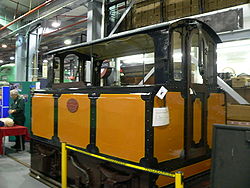 |
||
| Waterloo & City Waterloo & City Line The Waterloo & City line is a short underground railway line in London, which was formally opened on 11 July 1898. It has only two stations, Waterloo and Bank... |
75SSouthern Railway 75S was numbered DS75 by British railways. | Siemens | 6 | 1898 | Bo | Shildon Shildon Locomotion Museum Shildon Locomotion Museum is a railway museum in Shildon, County Durham, England. The museum is a branch of the National Railway Museum , which is part of the National Museum of Science and Industry... |
1978-7003 | ||
| NER North Eastern Railway (UK) The North Eastern Railway , was an English railway company. It was incorporated in 1854, when four existing companies were combined, and was absorbed into the London and North Eastern Railway at the Grouping in 1923... |
1Northern eastern electric locomotive number 1 was renumbered 4075 and then 6480 by the London and North Eastern railway. Under British Railways numbering it carried 26500. | (BR) ES1 British Rail Class ES1 British Rail Class ES1 was a class of two electric locomotives commissioned by the North Eastern Railway in 1902. They were of steeplecab design.... |
BTH British Thomson-Houston British Thomson-Houston was a British engineering and heavy industrial company, based at Rugby, Warwickshire, England. They were known primarily for their electrical systems and steam turbines. They were merged with the similar Metropolitan-Vickers company in 1928, but the two maintained their own... |
1904 | Bo-Bo Bo-Bo A Bo-Bo or Bo′Bo′ is a locomotive with two independent four-wheeled bogies with all axles powered by individual traction motors... |
Shildon | 1975-7022 |  |
|
| NSR North Staffordshire Railway The North Staffordshire Railway was a British railway company formed in 1845 to promote a number of lines in the Staffordshire Potteries and surrounding areas in Staffordshire, Cheshire, Derbyshire and Shropshire.... |
1North Staffordshire Railway battery electric locomotive number 1 later carried British Railways number BEL2. | Battery-electric | NSR / Thomas Bolton |
1917 | Bo | York National Railway Museum The National Railway Museum is a museum in York forming part of the British National Museum of Science and Industry and telling the story of rail transport in Britain and its impact on society. It has won many awards, including the European Museum of the Year Award in 2001... |
1978-7004 | ||
| BR | E26020Locomotive E26020 later carried the TOPS number 76020. | Class 76 British Rail Class 76 The British Rail Class 76, also known as Class EM1 , is a class of 1.5 kV DC, Bo-Bo electric locomotive designed for use on the now-closed Woodhead Line in Northern England.-Tommy — the prototype:... |
BR Gorton Gorton locomotive works Gorton Locomotive Works, known locally as Gorton Tank was located in Openshaw near Manchester, England and was completed in 1848 by the Sheffield, Ashton-under-Lyne and Manchester Railway.- History :... |
1027 | 1951 | Bo-Bo | York | 1978-7005 | 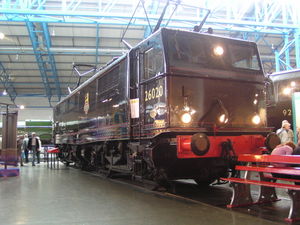 |
| BR | E5001Locomotive E5001 later carried the TOPS number 71001. | Class 71 British Rail Class 71 The British Rail Class 71 was an electric locomotive used on the Southern Region of British Railways, unlike most other Southern Region electric locomotives they could not operate away from the electrified system.- History :As part of the BTC Modernisation Plan of 1955, twenty-four electric... |
BR Doncaster Doncaster Works Doncaster railway works is in the town of Doncaster, South Yorkshire, England.Always referred to as "the Plant", it was established by the Great Northern Railway in 1853, replacing the previous works in Boston and Peterborough... |
— | 1958 | Bo-Bo | Shildon | 1978-7006 |  |
| BR | 84001Locomotive 84001 orriginally carried the number E3036. | Class 84 British Rail Class 84 The British Rail Class 84 was a 25 kV AC electric locomotive that operated on the West Coast Main Line of the London Midland Region.- History :... |
North British | 27793 | 1960 | Bo-Bo | Barrow Hill Barrow Hill Engine Shed Barrow Hill Roundhouse & Railway Centre, until 1948 known as Staveley Roundhouse & Train Centre, is a former Midland Railway roundhouse in Barrow Hill, near Staveley and Chesterfield, Derbyshire .-History:... |
1979-7001 |  |
| BR | 87001 Stephenson | Class 87 British Rail Class 87 The British Rail Class 87 is a type of electric locomotive built from 1973-75 by British Rail Engineering Limited . 36 of these locomotives were built to work passenger services over the West Coast Main Line . They were the flagships of British Rail's electric locomotive fleet until the late 1980s,... |
BREL Crewe Crewe Works Crewe railway works is a British railway engineering facility built in 1840 by the Grand Junction Railway. It is located in the town of Crewe, in the county of Cheshire.... |
— | 1974 | Bo-Bo | York | 2005-7698 |  |
Narrow gauge electric
| Railway | Number | Type or Class | Builder | Works Number |
Built | Wheels | Gauge | Location | Object Number | Image |
|---|---|---|---|---|---|---|---|---|---|---|
| Post Office London Post Office Railway The Post Office Railway, also known as Mail Rail, was a narrow-gauge driverless private underground railway in London built by the Post Office with assistance from the Underground Electric Railways Company of London to move mail between sorting offices... |
809 | 1930 stock London Post Office Railway 1930 Stock The London Post Office Railway 1930 Stock and 1936 Stock was built by English Electric. These units comprised the bulk of the fleet from the 1930s until the introduction of the 1980 Stock. The articulated units were designed to replace the earlier unsuccessful 1927 Stock, which were prone to... |
EE English Electric English Electric was a British industrial manufacturer. Founded in 1918, it initially specialised in industrial electric motors and transformers... |
809 | 1931 | A-1-1-A | York National Railway Museum The National Railway Museum is a museum in York forming part of the British National Museum of Science and Industry and telling the story of rail transport in Britain and its impact on society. It has won many awards, including the European Museum of the Year Award in 2001... |
1986-7000 | ||
Electric multiple units coaches
All these coaches are gauge unless noted otherwise.| Railway | Unit number | Unit class | Car number | Car type | Builder | Built | Location | Object Number | Image |
|---|---|---|---|---|---|---|---|---|---|
| NER | 3267 | Parcels | 1904 | North Shields Stephenson Railway Museum The Stephenson Railway Museum is managed by Tyne and Wear Museums on behalf on North Tyneside Council, and is located at Middle Engine Lane in North Shields, England.... |
1978-7067 | ||||
| SR | 1293 | 4-SUB British Rail Class 405 Under the British Rail TOPS computer system, Class 415 was allocated to surviving examples of the Southern Railway 4-Sub Class electric multiple units built between 1941 and 1951... |
8143 | York National Railway Museum The National Railway Museum is a museum in York forming part of the British National Museum of Science and Industry and telling the story of rail transport in Britain and its impact on society. It has won many awards, including the European Museum of the Year Award in 2001... |
1978-7069 | 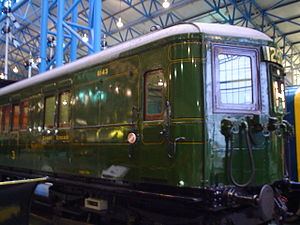 |
|||
| SR | 3131 | 4-COR British Rail Class 404 The Southern Railway gave the designations 4-COR, 4-RES, 4-BUF and 4-GRI to the different types of electric multiple unit built to work the route between London Waterloo and Portsmouth Harbour. The 4-COR type units survived long enough in British Rail ownership to be allocated TOPS Class 404... |
11179 | MBTO | 1937 | York | 1978-7071 | 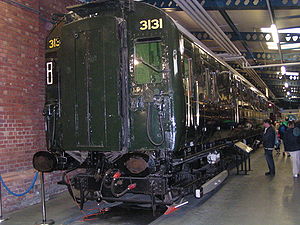 |
|
| LNWR | 1927 stock LNWR electric units During 1909-1922 the London and North Western Railway embarked on a project to electrify their London inner-suburban network, encompassing the lines from London Euston to Watford and the North London Railway from London Broad Street to Richmond, including branch lines such as Watford to Croxley... |
28249 | MBTO | 1915 | York | 1978-7068 | 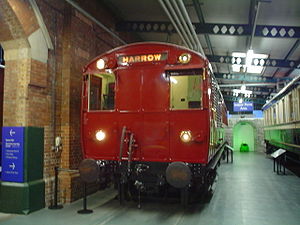 |
||
| SR | 2090 | 2-BIL British Rail Class 401 The Southern Railway gave the designation 2-BIL to the DC third rail electric multiple units built during the 1930s to work long-distance semi-fast services on the newly electrified lines from London to Eastbourne, Portsmouth and Reading... |
12123 | MBT | 1937 | Shildon Shildon Locomotion Museum Shildon Locomotion Museum is a railway museum in Shildon, County Durham, England. The museum is a branch of the National Railway Museum , which is part of the National Museum of Science and Industry... |
1985-7001 | ||
| SR | 2090 | 2-BIL | 10656 | DTC | 1937 | Shildon | 1985-7002 | ||
| BR (SR) | 3545 | 4-VEP British Rail Class 423 The British Rail Class 423 electrical multiple units were built by BR at York Works from 1967 to 1974, although the MBSOs and TSOs of the first 20, 7701-7720, were constructed at Derby Works. They feature manually-opening doors next to every seating row and were the last coaching stock built in... |
DTC | 1974 | Shildon | 2006-7360 | |||
| JR-West West Japan Railway Company , also referred to as , is one of the Japan Railways Group companies and operates in western Honshū. It has its headquarters in Kita-ku, Osaka.-History:... |
0 Series Shinkansen 0 Series Shinkansen The trains were the first Shinkansen trainsets built to run on Japan's new Tōkaidō Shinkansen high-speed line which opened in 1964. The last remaining trainsets were withdrawn in 2008.-History:... |
22–141 | Panto/Cab | 1976 | York | 2001-7500 | |||
| BR | Class 370 British Rail Class 370 British Rail's Class 370 tilting trains, also referred to as APT-P , were the pre-production Advanced Passenger Train units... |
2005 | Power car | BREL Crewe Crewe Works Crewe railway works is a British railway engineering facility built in 1840 by the Grand Junction Railway. It is located in the town of Crewe, in the county of Cheshire.... |
1980 | Shildon | 1988-7006/7 | ||
Electric tramcars
Standard gauge locomotives
The following locomotives are all gauge and powered by diesel engines unless noted otherwise.| Railway | Number | Type or Class |
Builder | Works Number |
Built | Wheels | Location | Object Number | Image |
|---|---|---|---|---|---|---|---|---|---|
| Petrol | Motor Rail | 4217 | 1925 | 4w PM | Shildon Shildon Locomotion Museum Shildon Locomotion Museum is a railway museum in Shildon, County Durham, England. The museum is a branch of the National Railway Museum , which is part of the National Museum of Science and Industry... |
||||
| CEGB CEGB The Central Electricity Generating Board was the cornerstone of the British electricity industry for almost 40 years; from 1957, to privatisation in the 1990s.... |
D21 Hexhamshire | Diesel electric | Armstrong Whitworth Armstrong Whitworth Sir W G Armstrong Whitworth & Co Ltd was a major British manufacturing company of the early years of the 20th century. Headquartered in Elswick, Newcastle upon Tyne, Armstrong Whitworth engaged in the construction of armaments, ships, locomotives, automobiles, and aircraft.-History:In 1847,... |
D21 | 1933 | 0-4-0 0-4-0 Under the Whyte notation for the classification of steam locomotives, 0-4-0 represents one of the simplest possible types, that with two axles and four coupled wheels, all of which are driven... |
Beamish | 1978-7008 | |
| LMS London, Midland and Scottish Railway The London Midland and Scottish Railway was a British railway company. It was formed on 1 January 1923 under the Railways Act of 1921, which required the grouping of over 120 separate railway companies into just four... |
7050 LMS diesel shunter 7050 LMS diesel shunter 7050 is a one-off diesel shunter railway locomotive, now preserved at the National Railway Museum.-History:The 7050 locomotive carried an original number of 7400 only within the Preston works where it was built, and was delivered as number 7050. It was loaned to the War... |
Diesel mechanical | Drewry Drewry Car Co. Drewry Car Co, strictly speaking, was a railway locomotive and railcar sales organisation for most of its life. Only at the start and the end of its life did it build its own products, relying on sub-contractors for the rest of its time... /EE English Electric English Electric was a British industrial manufacturer. Founded in 1918, it initially specialised in industrial electric motors and transformers... |
Drewry 2047 EE 874 |
1934 | 0-4-0 | York National Railway Museum The National Railway Museum is a museum in York forming part of the British National Museum of Science and Industry and telling the story of rail transport in Britain and its impact on society. It has won many awards, including the European Museum of the Year Award in 2001... |
2008-7160 | |
| BR British Rail British Railways , which from 1965 traded as British Rail, was the operator of most of the rail transport in Great Britain between 1948 and 1997. It was formed from the nationalisation of the "Big Four" British railway companies and lasted until the gradual privatisation of British Rail, in stages... |
13079Diesel shunter 13079 was renumbered D3079 but later carried TOPS number 08064. | Class 08 British Rail Class 08 The British Rail Class 08 is a class of diesel-electric shunting locomotive. From 1953 to 1962, 996 locomotives were produced, making it the most numerous of all British locomotive classes.... |
BR Darlington Darlington Works Darlington railway works, known in the town as North Road Shops, was built in 1863 by the Stockton and Darlington Railway in the town of Darlington in the north east of England.-NER History:The first new locomotive was built at the works in 1864... |
— | 1953 | 0-6-0 0-6-0 Under the Whyte notation for the classification of steam locomotives, 0-6-0 represents the wheel arrangement of no leading wheels, six powered and coupled driving wheels on three axles, and no trailing wheels... |
York | 1985-7000 | |
| BR | 08911Diesel shunter 08911 was originally numbered D4141. | Class 08 | 0-6-0 | York< | |||||
| EE English Electric English Electric was a British industrial manufacturer. Founded in 1918, it initially specialised in industrial electric motors and transformers... |
Deltic British Rail DP1 DP1, known as Deltic from the name painted on the sides, is a prototype demonstrator locomotive employing a Deltic engine, built by English Electric in 1955... |
Prototype | EE English Electric English Electric was a British industrial manufacturer. Founded in 1918, it initially specialised in industrial electric motors and transformers... |
2007 | 1955 | Co-Co | Shildon | 1963-80 | |
| BR | D8000D8000 later carried TOPS number 20050. | Class 20 British Rail Class 20 The British Rail Class 20, otherwise known as an English Electric Type 1, is a class of diesel-electric locomotive. In total, 228 locomotives in the class were built by English Electric between 1957 and 1968, the large number being in part because of the failure of other early designs in the same... |
EE English Electric English Electric was a British industrial manufacturer. Founded in 1918, it initially specialised in industrial electric motors and transformers... /Vulcan Vulcan Foundry Vulcan Foundry was a British locomotive builder sited at Newton-le-Willows, Lancashire .-History:It was originally opened in 1832 as Charles Tayleur and Company to produce girders for bridges, switches and crossings, and other ironwork following the opening of the Liverpool and Manchester Railway... |
EE 2347 VF D375 | 1957 | Bo-Bo Bo-Bo A Bo-Bo or Bo′Bo′ is a locomotive with two independent four-wheeled bogies with all axles powered by individual traction motors... |
York | 1981-7002 | |
| BR | D5500D5500 later carried TOPS number 31018. | Class 31/0 British Rail Class 31 The British Rail Class 31 diesel locomotives, also known as the Brush Type 2 and originally as Class 30, were built by Brush Traction from 1957-62.- Description :... |
Brush Brush Traction This article is about a British rail-locomotive maker. For the Detroit auto-maker, see Brush Motor Car CompanyBrush Traction is a manufacturer and maintainer of railway locomotives, part of the FKI group , based at Loughborough in Leicestershire, England situated alongside the Midland Main Line.-... |
71 | 1957 | A1A-A1A | York | 1978-7000 |  |
| BR | D200D200 later carried TOPS number 40122. | Class 40 British Rail Class 40 The British Rail Class 40 is a type of British railway diesel locomotive. Built by English Electric between 1958 and 1962, and eventually numbering 200, they were for a time the pride of the British Rail early diesel fleet... |
EE/Vulcan | EE 2367 VF D395 | 1958 | 1Co-Co1 | York | 1988-7001 | |
| BR | D2090D2090 later carried TOPS number 03090. | Class 03 British Rail Class 03 The British Rail Class 03 locomotive is, together with Class 04, one of BR's most successful smaller 0-6-0 diesel-mechanical shunters. The class, numbering 230 examples, was built by British Railways' Swindon and Doncaster works in 1957-1962 and numbered D2000-D2199 and D2370-D2399... |
BR Doncaster Doncaster Works Doncaster railway works is in the town of Doncaster, South Yorkshire, England.Always referred to as "the Plant", it was established by the Great Northern Railway in 1853, replacing the previous works in Boston and Peterborough... |
— | 1960 | 0-6-0 | Shildon | 1976-7005 | |
| BR | D6535D6535 was converted to a Class 33/1 in 1967 and alter carried the TOPS number 33116. | Class 33/1 British Rail Class 33 The British Rail Class 33 also known as the BRCW Type 3 or Crompton is a class of Bo-Bo diesel-electric locomotives ordered in 1957 and built for the Southern Region of British Railways between 1960 and 1962.... |
BRC&W Birmingham Railway Carriage and Wagon Company The Birmingham Railway Carriage and Wagon Company was a railway locomotive and carriage builder, founded in Birmingham, England and, for most of its existence, located at nearby Smethwick, with the factory was divided by the boundary between the two places... |
DEL 127 | 1960 | Bo-Bo | GCR Great Central Railway (preserved) The Great Central Railway is a heritage railway split into two adjacent sections, one in Leicestershire and the other Nottinghamshire.The Leicestershire section is currently Britain's only double track mainline heritage railway, with of working double track, period signalling, locomotives and... |
2005-7286 | |
| BR | D2860 | Class 02 British Rail Class 02 The British Rail Class 02 were a class of twenty 0-4-0 diesel-hydraulic shunting locomotives built by the Yorkshire Engine Company in 1960 and 1961 for service in areas of restricted loading gauge and curvature such as docks... |
Yorkshire Engine Co. Yorkshire Engine Company The Yorkshire Engine Company was a small independent locomotive manufacturer in Sheffield, England. The Company was formed in 1865 and continued to produce locomotives and carry out general engineering work until 1965... |
2843 | 1961 | 0-4-0 | York | 1978-7001 | |
| BR | D6700D6700 later carried TOPS number 37119 until modified to Class 37/3 when it became 37350. | Class 37 British Rail Class 37 The British Rail Class 37 is a diesel-electric locomotive. Also known as the English Electric Type 3, the Class was ordered as part of the British Rail modernisation plan.... |
EE/Vulcan | EE 2863 VF D579 | 1961 | Co-Co | York | 2001-7861 | |
| BR | D9002 Kings Own Yorkshire Light InfantryD9002 later carried TOPS number 55002. | Class 55 British Rail Class 55 The British Rail Class 55 is a class of diesel locomotive built in 1961 and 1962 by English Electric. They were designed for the high-speed express passenger services on the East Coast Main Line between and Edinburgh. They gained the name "Deltic" from the prototype locomotive, DP1 Deltic, which... |
EE/Vulcan | EE 2907 VF D559 | 1961 | Co-Co | York | 1987-7002 |  |
| BR | D1023 Western Fusilier | Class 52 British Rail Class 52 British Rail assigned Class 52 to the class of 74 large Type 4 diesel-hydraulic locomotives built for the Western Region of British Railways between 1961 and 1964... |
BR Swindon Swindon Works Swindon railway works were built by the Great Western Railway in 1841 in Swindon in the English county of Wiltshire.-History:In 1835 Parliament approved the construction of a railway between London and Bristol. Its Chief Engineer was Isambard Kingdom Brunel.From 1836, Brunel had been buying... |
— | 1963 | C-C | York | 1978-7002 | |
| BR | 47798 Prince WilliamClass 47 locomotive number D1656 became 47072 in 1974 after the TOPS numbering system came into use. Its steam heating boiler was replaced by electric train heating in 1984 and therefore renumbered 47609. The following year it was given the name Fire Fly to commemorate an historic Great Western Railway steam locomotive and was further renmubered to 47834 in 1989. In 1995 it was renumbered once more to 47798 and the name changed to Prince William; it was also repainted in plum colour as one of the locomotives allocated to pull the British Royal Train. | Class 47 British Rail Class 47 The British Rail Class 47, is a class of British railway diesel-electric locomotive that was developed in the 1960s by Brush Traction. A total of 512 Class 47s were built at Crewe Works and Brush's Falcon Works, Loughborough between 1962 and 1968, which made them the most numerous class of British... |
BR Crewe Crewe Works Crewe railway works is a British railway engineering facility built in 1840 by the Grand Junction Railway. It is located in the town of Crewe, in the county of Cheshire.... |
— | 1965 | Co-Co | York | 2004-7243 | 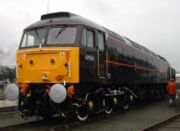 |
| BR | 4100141001 was one of the two power cars of the prototype High Speed Diesel Train which, as a complete train, carried the number 252001. It carried car number 43000 and later ADB975812 when no longer in revenue service. | Prototype HST British Rail Class 41 (HST) The British Rail Class 41 was the original classification for the power cars of the prototype High Speed Train. However, the train was later re-classified as a diesel-electric multiple unit, and the whole set became Class 252. They were of Bo-Bo wheel arrangement.Two power cars were built, 41001... |
BREL Crewe Crewe Works Crewe railway works is a British railway engineering facility built in 1840 by the Grand Junction Railway. It is located in the town of Crewe, in the county of Cheshire.... |
— | 1972 | Bo-Bo | York | 1988-7000 | |
Narrow gauge locomotives
These locomotives are all powered by diesel engines unless noted otherwise.| Railway | Number | Type | Builder | Works Number |
Built | Wheels | Gauge | Location | Object Number | Image |
|---|---|---|---|---|---|---|---|---|---|---|
| Yorkshire Water AuthoritySimplex 2275 worked at Knostrop Sewage Works but was originally built for the War Department Light Railways. | Simplex No 2275 | Petrol | Motor Rail Motor Rail Motor Rail was a British locomotive-building company, based in Bedford. Formed in 1911 as The Motor Rail & Tramcar Co Ltd, they built petrol and diesel engined locomotives, mainly narrow gauge. During World War I over 900 locos were supplied for use on temporary military supply railways... |
1377 | 1918 | 4w | Leighton Buzzard Leighton Buzzard Light Railway The Leighton Buzzard Light Railway is a narrow gauge light railway in Leighton Buzzard in Bedfordshire, England. It operates on a gauge, and is just under long. The line was built after the First World War to serve sand quarries north of the town... http://www.djr12ecg.demon.co.uk/spx/40_h.htm |
|||
| Yorks. Water AuthorityRuston Hornsby 187105 was used by the Yorkshire water Authority at Naburn Naburn Naburn is a small village and civil parish in the unitary authority of the City of York in North Yorkshire, England. It lies on the eastern side of the River Ouse about south of York. According to the 2001 census the parish had a population of 470... Sewage Works. |
Ruston Hornsby Ruston (engine builder) Ruston & Hornsby, later known as Ruston, was an industrial equipment manufacturer in Lincoln, England, the company's history going back to 1840. The company is best known as a manufacturer of narrow and standard gauge diesel locomotives and also of steam shovels. Other products included cars, steam... |
187105 | 1937 | 4w | Leighton Buzzard | 1978-7046 | ||||
| NCB National Coal Board The National Coal Board was the statutory corporation created to run the nationalised coal mining industry in the United Kingdom. Set up under the Coal Industry Nationalisation Act 1946, it took over the mines on "vesting day", 1 January 1947... Number 14 was operated by the National Coal Board at Ellington Colliery, Northumberland. |
14 | Hudswell Clarke Hudswell Clarke Hudswell, Clarke and Company Limited was an engineering and locomotive building company in Jack Lane, Hunslet, Leeds, West Yorkshire, England.-History:... |
1962 | 0-6-0 | Shildon Shildon Locomotion Museum Shildon Locomotion Museum is a railway museum in Shildon, County Durham, England. The museum is a branch of the National Railway Museum , which is part of the National Museum of Science and Industry... |
2005-7601 | ||||
| NCB Number 9 was operated by the National Coal Board at Ellington Colliery, Northumberland. | 9 | Hunslet Hunslet Engine Company The Hunslet Engine Company is a British locomotive-building company founded in 1864 at Jack Lane, Hunslet, Leeds, West Yorkshire, England by John Towlerton Leather, a civil engineering contractor, who appointed James Campbell as his Works Manager.In 1871, James Campbell bought the company for... |
9227 | 1986 | Bo-Bo | Shildon | 2005-7600 | |||
Diesel multiple unit coaches
All these coaches are gauge and power by diesel engines unless noted otherwise.| Railway | Number | Class or Type | Builder | Works Number |
Built | Location | Object Number | Image |
|---|---|---|---|---|---|---|---|---|
| GWR | 4 | Railcar | AEC | 1934 | Swindon | 1978-7070 | ||
| BR | 51192 + 54352 | 2-car Class 101 British Rail Class 101 The British Rail Class 101 diesel multiple units were built by Metro-Cammell at Washwood Heath in Birmingham from 1956 to 1959, following construction of a series of prototype units. This class proved to be the most successful and longest-lived of all BR's First Generation DMUs, with the final five... |
Metro Cammell | ELR East Lancashire Railway The East Lancashire Railway is a heritage railway in Lancashire and Greater Manchester, England.-Overview:After formal closure by British Rail in 1982, the line was reopened on 25 July 1987. The initial service operated between Bury and Ramsbottom, via Summerseat. In 1991 the service was extended... |
2004-7105 | |||
| BR | APT-E | Gas turbine prototype APT | BR Derby | Shildon | 1976-7002 | 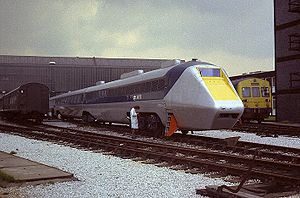 |
||
| BR | LEV1 | Experimental railbus | Leyland | 1975 | NNR North Norfolk Railway The North Norfolk Railway – also known as the "Poppy Line" – is a heritage steam railway in Norfolk, England, running between the coastal town of Sheringham and Holt, It cuts through the countryside to the east of Weybourne with views of its windmill and passes through the well preserved country... |
1987-7017 | 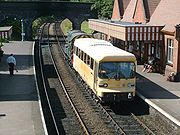 |
|

